Samsung UE46C8705, UE40C8705, UE55C8705 User Manual

Contact SAMSUNG WORLDWIDE
If you have any questions or comments relating to Samsung products, please contact the SAMSUNG customer care centre.
Country |
Customer Care Centre |
Web Site |
AUSTRIA |
0810 - SAMSUNG (7267864, € 0.07/min) |
www.samsung.com/at |
BELGIUM |
02-201-24-18 |
www.samsung.com/be (Dutch) |
|
|
www.samsung.com/be_fr (French) |
CZECH |
800 - SAMSUNG (800-726786) |
www.samsung.com/cz |
|
Samsung Zrt., česká organizační složka, Oasis Florenc, Sokolovská394/17, 180 00, Praha 8 |
|
DENMARK |
70 70 19 70 |
www.samsung.com/dk |
FINLAND |
030 - 6227 515 |
www.samsung.com/fi |
FRANCE |
01 48 63 00 00 |
www.samsung.com/fr |
GERMANY |
01805 - SAMSUNG (726-7864 € 0,14/Min) |
www.samsung.de |
HUNGARY |
06-80-SAMSUNG (726-7864) |
www.samsung.com/hu |
ITALIA |
800-SAMSUNG (726-7864) |
www.samsung.com/it |
LUXEMBURG |
261 03 710 |
www.samsung.com/lu |
NETHERLANDS |
0900-SAMSUNG (0900-7267864) (€ 0,10/Min) |
www.samsung.com/nl |
NORWAY |
815-56 480 |
www.samsung.com/no |
POLAND |
0 801 1SAMSUNG (172678) |
www.samsung.com/pl |
|
022-607-93-33 |
|
PORTUGAL |
80820-SAMSUNG (726-7864) |
www.samsung.com/pt |
SLOVAKIA |
0800-SAMSUNG (726-7864) |
www.samsung.com/sk |
SPAIN |
902 - 1 - SAMSUNG (902 172 678) |
www.samsung.com/es |
SWEDEN |
0771 726 7864 (SAMSUNG) |
www.samsung.com/se |
Turkey |
444 77 11 |
www.samsung.com/tr |
U.K |
0845 SAMSUNG (7267864) |
www.samsung.com/uk |
EIRE |
0818 717100 |
www.samsung.com/ie |
Switzerland |
0848 - SAMSUNG (7267864, CHF 0.08/min) |
www.samsung.com/ch |
|
|
www.samsung.com/ch_fr/(French) |
LITHUANIA |
8-800-77777 |
www.samsung.com/lt |
LATVIA |
8000-7267 |
www.samsung.com/lv |
ESTONIA |
800-7267 |
www.samsung.com/ee |
manual user TV LED
LED TV
user manual
imagine the possibilities
Thank you for purchasing this Samsung product. To receive more complete service, please register your product at
www.samsung.com/register
Model______________ Serial No.______________
© 2010 Samsung Electronics Co., Ltd. All rights reserved. |
BN68-02849C-01 |
|
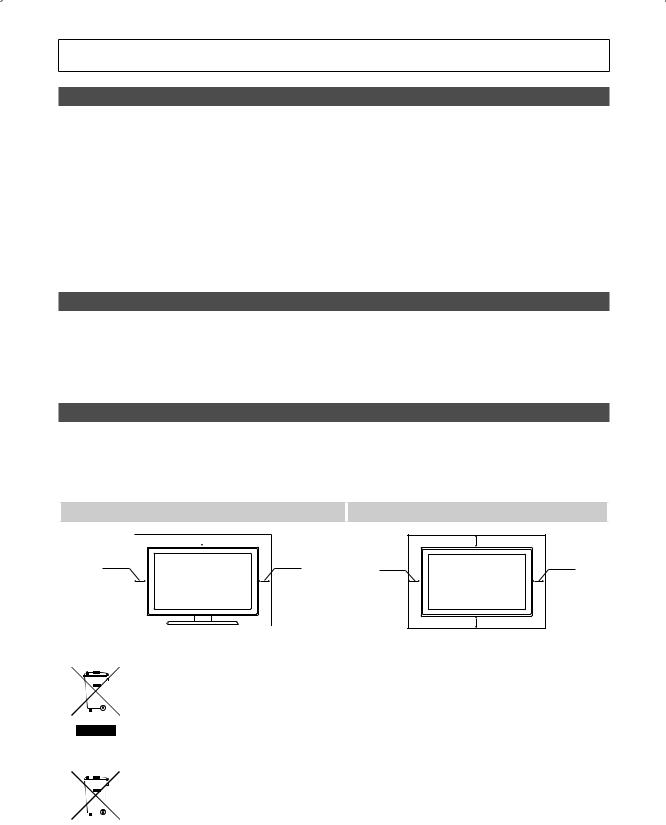
Figures and illustrations in this User Manual are provided for reference only and may differ from actual product appearance. Product design and specifications may be changed without notice.
Digital TV notice
1.Functionalities related to Digital TV (DVB) are only available in countries/areas where DVB-T (MPEG2 and MPEG4 AVC) digital terrestrial signals are broadcasted or where you are able to access to a compatible DVB-C (MPEG2 and MPEG4 AAC) cable-TV service. Please check with your local dealer the possibility to receive DVB-T or DVB-C signal.
2.DVB-T is the DVB European consortium standard for the broadcast transmission of digital terrestrial television and DVB-C is that for the broadcast transmission of digital TV over cable. However, some differentiated features like EPG (Electric Programme Guide), VOD (Video On Demand) and so on, are not included in this specification. So, they cannot be workable at this moment.
3.Although this TV set meets the latest DVB-T and DVB-C standards, as of [August, 2008], the compatibility with future DVB-T digital terrestrial and DVB-C digital cable broadcasts cannot be guaranteed.
4.Depending on the countries/areas where this TV set is used some cable-TV providers may charge an additional fee for such a service and you may be required to agree to terms and conditions of their business.
5.Some Digital TV functions might be unavailable in some countries or regions and DVB-C might not work correctly with some cable service providers.
6.For more information, please contact your local Samsung customer care centre.
The reception quality of TV may be affected due to differences in broadcasting method between the countries. Please check the TV performance in the local SAMSUNG Authorized Dealer, or the Samsung Call Centre whether it can be improved by reconfiguring TV setting or not.
Still image warning
Avoid displaying still images (like jpeg picture files) or still image element (like TV programme logo, panorama or 4:3 image format, stock or news bar at screen bottom etc.) on the screen. Constant displaying of still picture can cause ghosting of LED screen, which will affect image quality. To reduce risk of this effect, please follow below recommendations:
•Avoid displaying the same TV channel for long periods.
•Always try do display any image on full screen, use TV set picture format menu for best possible match.
•Reduce brightness and contrast values to minimum required to achieve desired picture quality, exceeded values may speed up the burnout process.
•Frequently use all TV features designed to reduce image retention and screen burnout, refer to proper user manual section for details.
Securing the Installation Space
Keep the required distances between the product and other objects (e.g. walls) to ensure proper ventilation.
Failing to do so may result in fire or a problem with the product due to an increase in the internal temperature of the product.
When using a stand or wall-mount, use parts provided by Samsung Electronics only.
xx If you use parts provided by another manufacturer, it may result in a problem with the product or an injury due to the product falling.The appearance may differ depending on the product.
Installation with a stand. |
Installation with a wall-mount. |
 10 cm
10 cm
10 cm |
10 cm |
|
10 cm |
10 cm |
10 cm |
|
10 cm |
Correct Disposal of This Product (Waste Electrical & Electronic Equipment)
(Applicable in the European Union and other European countries with separate collection systems)
This marking on the product, accessories or literature indicates that the product and its electronic accessories (e.g. charger, headset, USB cable) should not be disposed of with other household waste at the end of their working life. To prevent possible harm to the environment or human health from uncontrolled waste disposal, please separate these items from other types of waste and recycle them responsibly to promote the sustainable reuse of material resources. Household users should contact either the retailer where they purchased this product, or their local government office, for details of where and how they can take these items for environmentally safe recycling. Business users should contact their supplier and check the terms and conditions of the purchase contract. This product and its electronic accessories should not be mixed with other commercial wastes for disposal.
Correct disposal of batteries in this product
(Applicable in the European Union and other European countries with separate battery return systems.)
This marking on the battery, manual or packaging indicates that the batteries in this product should not be disposed of with other household waste at the end of their working life. Where marked, the chemical symbols Hg, Cd or Pb indicate that the battery contains mercury, cadmium or lead above the reference levels in EC Directive 2006/66. If batteries are not properly disposed of, these substances can cause harm to human health or the environment. To protect natural resources and to promote material reuse, please separate batteries from other types of waste and recycle them through your local, free battery return system.
2English

Contents
Getting Started
4
Connections
8
Basic Features
12
Advanced Features
29
Other Information
55
4Accessories
5Viewing the Control Panel
6Viewing the Remote Control
7Connecting to an Antenna
7Plug & Play (Initial Setup)
8Connecting to an AV Device
10Connecting to an Audio Device
11Changing the Input Source
12 How to Navigate Menus
12 Using the INFO button (Now & Next guide)
12 Planning Your Viewing
14 Channel Menu
17 Picture Menu
23 Sound Menu
25 Setup Menu
28Support Menu
29Connecting to a PC
30Network Connection
37Media Play
46Anynet+
50Internet@TV
53AllShare
55Analogue Channel Teletext Feature
56Assembling the Cables
57Installing the Wall Mount
59Anti-theft Kensington Lock
59Securing the TV to the wall
60Troubleshooting
64Specifications
65Index
Check the Symbol!
t
TOOLS |
This function can be used by |
Note |
One-Touch Button |
|
|
|
|
|
pressing the TOOLS button on the |
|
|
|
remote control. |
|
|
ENGLISH
English 3
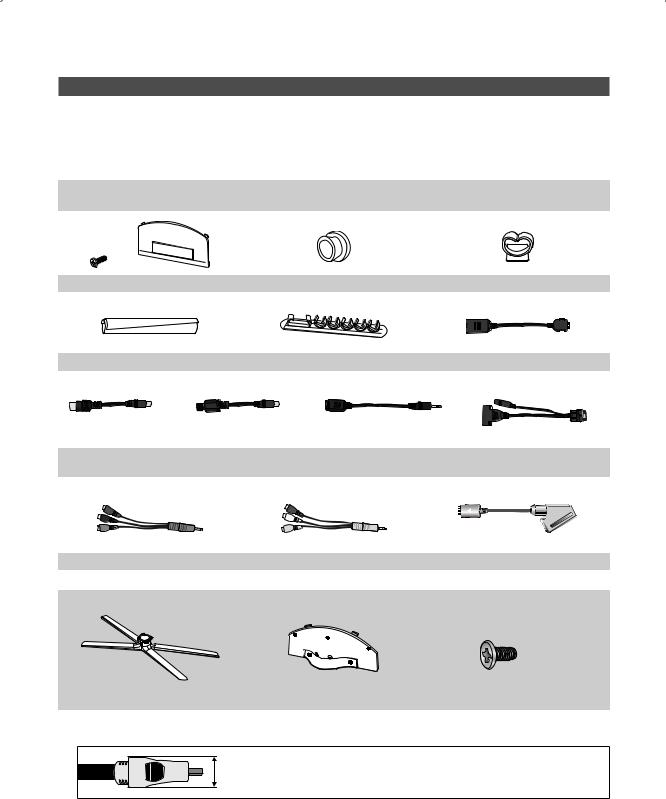
Getting Started
Accessories
Please make sure the following items are included with your LED TV. If any items are missing, contact your dealer. |
|||
The items’ colours and shapes may vary depending on the models. |
|
|
|
Cables not included in the package contents can be purchased separately. |
|
||
[[ |
|
|
|
CAUTION: INSERT SECURELY LEST SHOULD BE DETACHED IN SET |
|
||
yy Remote Control & Batteries (AAA x 2) |
|
yy |
Cleaning Cloth |
yy Warranty Card / Safety Guide (Not available in some locations) |
yy |
Owner’s Instructions |
|
(M4 X L8) |
|
|
|
yy Blanking Bracket & Screw (X1) |
yy Holder-Ring (4EA) |
|
yy Holder-Wire stand |
|
|
|
|
|
|
|
|
|
|
yy Cable Tie |
yy Holder-Wire (3EA) |
yy LAN Adapter |
||
yy Antenna Adapter |
yy Antenna Adapter |
yy Optical Adapter |
yy PC Adapter |
(Air / Cable) |
(Satellite) |
|
|
yy Component Adapter |
yy AV Adapter |
See separate guide for installing the stand.
s |
|
s |
|
|
|
|
s |
s |
|
|
s |
yy SCART Adapter (2EA)
M4 X L8
yy Stand (1EA) |
yy Guide Stand (1EA) |
yy Screws (9EA) |
For best cable connection to this product, be sure to use cables with a maximum thickness as below:
yy Maximum thickness - 0.55 inches (14mm)
4English
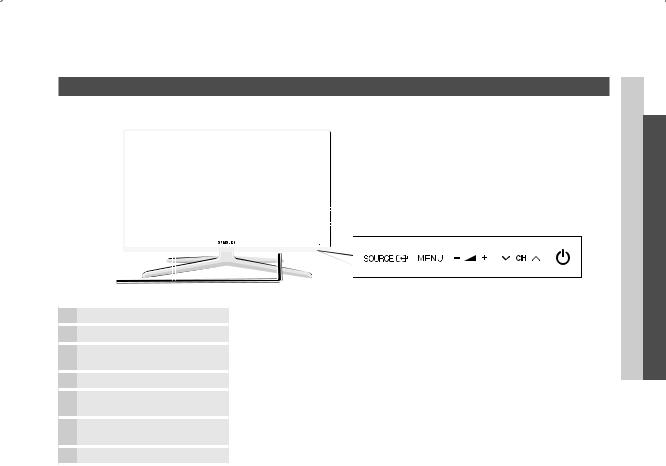
Viewing the Control Panel
The product colour and shape may vary depending on the model.
 Getting Started01
Getting Started01
|
|
|
|
|
Remote control sensor |
|
|
|
|
|
Power Indicator |
|
|
|
|
|
|
|
|
|
|
||
Speakers |
|
|
|
|
|
|
|
|
|
||
Remote control sensor |
Aim the remote control towards this spot on the TV. |
||||
Power Indicator |
Blinks and turns off when the power is on and lights up in standby mode. |
||||
SOURCEE |
Toggles between all the available input sources. In the on-screen menu, use this |
||||
|
|
|
button as you would use the ENTEREbutton on the remote control. |
||
MENU |
Displays an on-screen menu, the OSD (on screen display), of your TV’s features. |
||||
Y |
Adjusts the volume. In the OSD, use the Ybuttons as you would use the |
||||
|
|
|
◄ and ► buttons on the remote control. |
||
z |
Changes the channels. In the OSD, use the zbuttons as you would use the |
||||
|
|
|
▼ and ▲ buttons on the remote control. |
||
P(Power) |
Turns the TV on or off. |
||||
Standby mode
Do not leave your TV in standby mode for long periods of time (when you are away on a holiday, for example). A small amount of electric power is still consumed even when the power button is turned off. It is best to unplug the power cord.
English 5
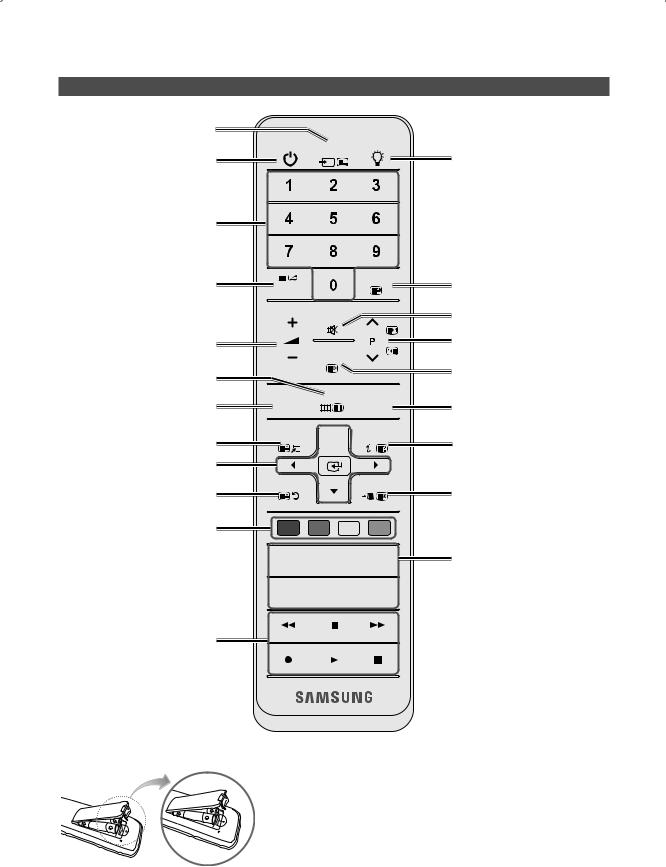
Getting Started
Viewing the Remote Control
Displays and selects the available video sources (p. 11).
Turns the TV on and off.
Have direct access to channels.
Alternately select Teletext ON, Double, Mix or OFF.
Adjusts the volume.
Opens the OSD.
POWER SOURCE ON/OFF
TTX/MIX PRE-CH
MUTE
CH LIST
Turns the remote control light on or off. When on, the buttons become
illuminated for a moment when pressed. (Using the remote control with this button set to On will reduce the battery usage time.)
Returns to the previous channel.
Cuts off the sound temporarily.
Changes channels.
Displays channel lists on the screen (p. 14).
Displays the Content View, which includes Guide, 3D, Internet@TV, Media Play, and AllShare.
Quickly select frequently used functions.
Selects the on-screen menu items and changes the values seen on the menu.
Returns to the previous menu.
These buttons are for the
Channel Manager, Internet@TV,
Media Play menu, etc.
Use these buttons in Media Play and
Anynet+ (HDMI-CEC) modes. (p. 37, 46) (The button also controls recording for Samsung recorders that support the Anynet+(HDMI-CEC),TimeShift and PVR features.)
Installing batteries (Battery size: AAA)
6English
CONTENT MENU GUIDE
TOOLS  INFO
INFO
RETURN EXIT
A |
B |
C |
D |
MEDIA.P |
INTERNET |
3D |
|
|
@TV |
||
|
|
|
|
AD |
|
P.SIZE |
SUBT. |
Displays the EPG (Electronic Programme
Guide) (p.12).
Displays information on the TV screen.
Exits the menu.
MEDIA.P: Displays Media Play (p. 37).
INTERNET@TV: Link to various internet services (p. 50).
3D: Sets the video, which provided with
3D signal (p. 21).
AD: Turns the audio description on and off (p. 24). This is not available in some locations.
P.SIZE: Selects the picture size (p. 19). SUBT.: Displays digital subtitles (p. 26).
NOTE
xx Use the remote control within 23 feet from the TV.
xx Bright light may affect the performance of the remote control. Avoid using nearby special fluorescent light or neon signs.
xx The colour and shape may vary depending on the model.
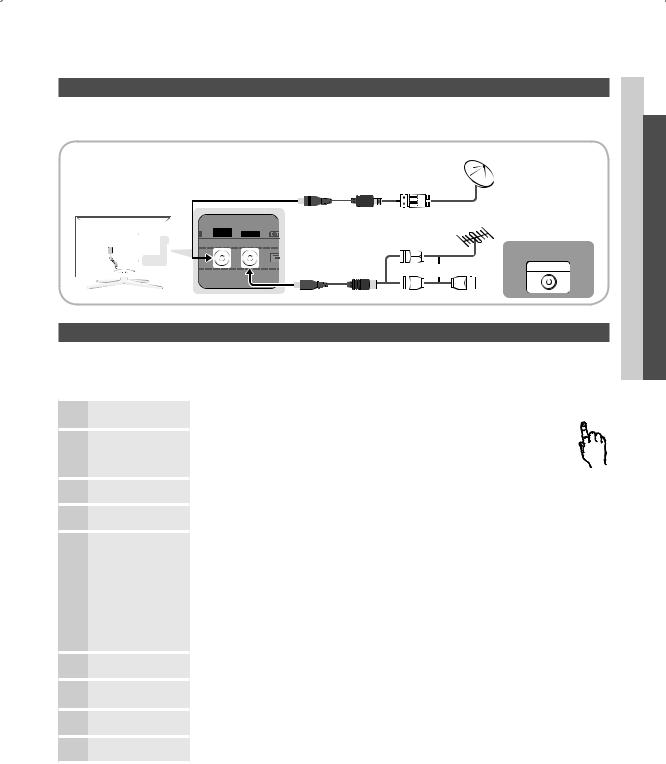
Connecting to an Antenna
When the TV is initially powered on, basic settings proceed automatically.Preset: Connecting the mains and antenna.
Satellite Antenna
 Getting Started01
Getting Started01
VHF/UHF Antenna
|
Cable |
or |
ANT OUT |
Plug & Play (Initial Setup)
When the TV is initially powered on, a sequence of on-screen prompts will assist in configuring basic settings. Press the POWERPbutton. Plug & Play is available only when the Input source is set to TV.
To return to the previous step, press the Red button.
1 |
Selecting a language |
2 |
Selecting Store Demo or |
Home Use |
|
3 |
Selecting a country |
4 |
Selecting an antenna |
5 |
Selecting a channel |
6 |
Setting the Clock Mode |
7 |
Time Zone |
8 |
Viewing the |
HD Connection Guide. |
|
9 |
Enjoy your TV. |
Press the ▲ or ▼ button, then press the ENTEREbutton. |
POWER |
Select the desired OSD (On Screen Display) language. |
P |
Press the ◄ or ► button, then press the ENTEREbutton. |
|
• Select the Home Use mode. Store Demo Mode is for retail environments. |
|
•To return the unit’s settings from Store Demo to Home Use (standard): Press the volume button on the TV. When the OSD volume is displayed, press and hold MENU for 5 sec.
Press the ▲ or ▼ button, then press the ENTEREbutton. Select the appropriate country.
Press the ▲ or ▼ button, then press the ENTEREbutton. Select Air, Cable or Satellite.
Press the ▲ or ▼ button, then press the ENTEREbutton.
Select the channel source to memorise. When setting the antenna source to Cable, a step appears allowing you to assign numerical values (channel frequencies) to the channels. For more information, refer to Channel →
Auto Store (p. 14).
When Air or Cable is selected first: After all Air or Cable channels are stored, the step for storing Satellite channels is displayed.
When Satellite is selected first: After all Satellite channels are stored, the step for storing Air or Cable channels is displayed.
Press the ENTEREbutton at any time to interrupt the memorisation process.
Set the Clock Mode automatically or manually.
Press the ▲ or ▼ button to select Auto, then press the ENTEREbutton.
Press the ▲ or ▼ button to select the your time zone, then press the ENTEREbutton. (depending on the country)
The connection method for the best HD screen quality is displayed.
Press the ENTEREbutton.
If You Want to Reset This Feature...
Select Setup - Plug & Play (Initial Setup). Enter your 4 digit PIN number. The default PIN number is “0-0-0-0.” If you want to change the PIN number, use the Change PIN function.
English 7
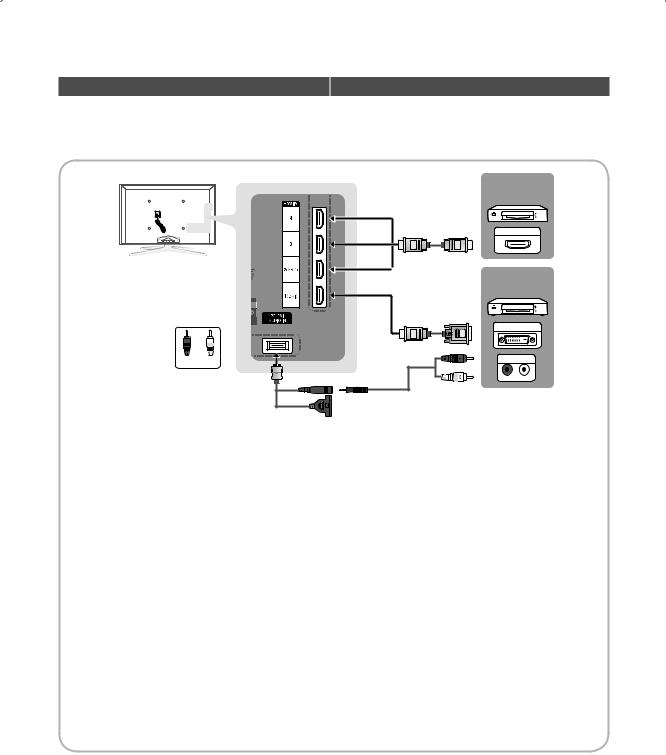
Connections
Connecting to an AV Device
Using an HDMI or HDMI/DVI cable: HD connection (up to 1080p)
Available devices: DVD, Blu-ray player, HD cable box, HD STB (Set-Top-Box) satellite receiver, cable box, satellite receiver (STB)
DVD /
Blu-ray player
HDMI OUT
DVD /
Blu-ray player
DVI OUT
R
W
Red |
White |
AUDIO OUT |
|
|
R-AUDIO-L |
HDMI IN 1(DVI), 2(ARC), 3, 4, PC/DVI AUDIO IN
xx When using an HDMI/DVI cable connection, you must use the HDMI IN 1(DVI) jack. For the DVI cable connection, use a DVI to HDMI cable or DVI-HDMI (DVI to HDMI) adapter for video connection and the PC/DVI AUDIO IN jacks for audio.
xx If an external device such as a DVD / Blu-ray player / cable box / STB satellite receiver supporting a HDMI versions older than 1.4 is connected, the TV may operate abnormally (e.g. no screen display / no sound / annoying flicker / abnormal colour).
xx If there is no sound after connecting an HDMI cable, check the HDMI version of the external device. If you suspect the version is older than 1.4, contact the provider of the device to confirm the HDMI version and request an upgrade.
xx Samsung TVs support the HDMI 1.4 (with 3D and Audio Return Channel). However, the ARC(Audio Return Channel) function is only supported on HDMI IN 2(ARC).
––If 3D Auto View is On, some functions, such as Internet@TV, are disabled. If this is a problem, set
3D Auto View or 3D Mode to Off.
xx The ARC function enables digital output of sound using the HDMI IN 2(ARC) port and can only be operated when the TV is connected to an audio receiver that supports the ARC function.
––The ARC Single mode is only enabled when the TV is connected to the device when using an HDMI Standard cable, HDMI High Speed cable, Hdmi Standard with Ethernet cable, HDMI High Speed with Ethernet cable.
––When the Input Source is the TV, the ARC function allows audio to be heard from a receiver. The audio is sent to a receiver from the TV via an HDMI cable without the need for a separate optical cable.
xx It is recommended you purchase an HDMI-certified cable. Otherwise, the screen may appear blank or a connection error may occur.
8English
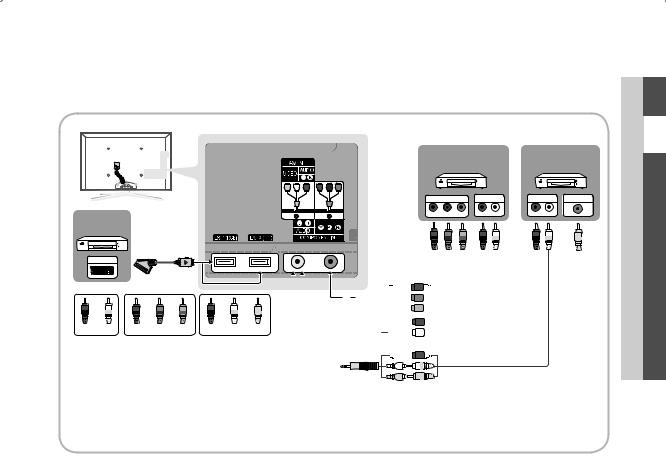
Using a Component (up to 1080p) or Audio/Video (480i only) and Scart Cable
Available devices: DVD, Blu-ray player, cable box, STB satellite receiver, VCR
DVD / |
VCR |
|
Blu-ray player |
||
|
||
COMPONENT OUT AUDIO OUT |
AUDIO OUT VIDEO OUT |
PR PB Y |
R-AUDIO-L |
R-AUDIO-L |
|
||||
VCR / DVD |
|
|
|
|
|
|
|
R |
B |
G |
R |
W |
R |
W |
Y |
AV |
|
|
|
|
|
|
|
EXT
R |
W |
R |
B |
G |
R |
W |
Y |
Red White Red Blue Green Red White Yellow
























 W R W R G B R
W R W R G B R



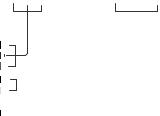






Y |
In Ext.1, Ext.2 mode, DTV Out supports MPEG SD Video and Audio only.
To obtain the best picture quality, the Component connection is recommended over the A/V connection.
 Connections 02
Connections 02
English 9
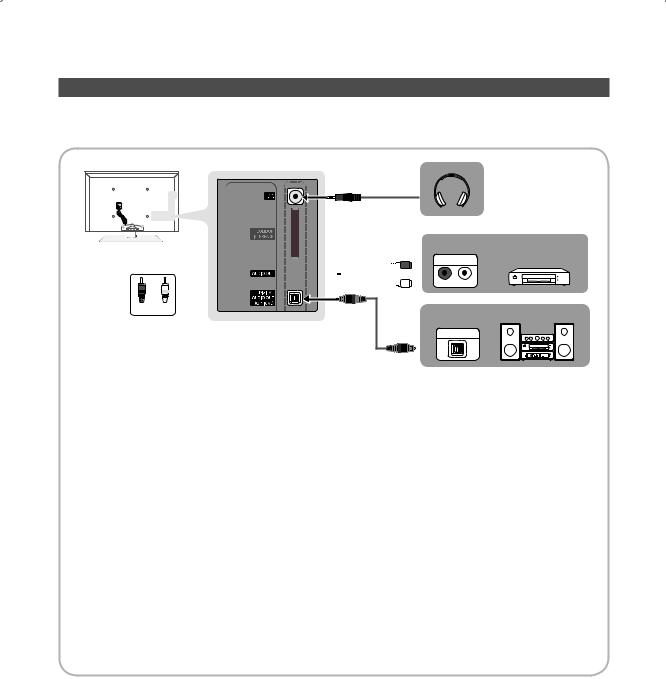
Connections
Connecting to an Audio Device
Using an Optical (Digital) or Audio (Analogue) Cable or Headphone Connection
Available devices: digital audio system, amplifier, DVD home theatre
R |
W |
Red White
DIGITAL AUDIO OUT (OPTICAL)

























 W R
W R
AUDIO IN
R-AUDIO-L
OPTICAL
amplifier, DVD home theatre
digital audio system
xx When a digital audio system is connected to the DIGITAL AUDIO OUT (OPTICAL) jack, decrease the volume of both the TV and the system.
xx 5.1 CH (channel) audio is available when the TV is connected to an external device supporting 5.1 CH.
xx When the receiver (home theatre) is set to on, you can hear sound output from the TV’s optical jack. When the TV is receiving a DTV signal, the TV will send 5.1 CH sound to the home theatre receiver. When the source is a digital component such as a DVD / Blu-ray player / cable box / STB (Set-Top-Box) satellite receiver and is connected to the TV via HDMI, only 2 CH audio will be heard from the home theatre receiver. If you want to hear 5.1 CH audio, connect the digital audio out jack from your DVD / Blu-ray player / cable box / STB satellite receiver directly to an amplifier or home theatre.
Headphones H: You can connect your headphones to the headphones output on your set. While the headphones are connected, the sound from the built-in speakers will be disabled.
xx Sound function may be restricted when connecting headphones to the TV. xx Headphone volume and TV volume are adjusted separately.
AUDIO OUT: Connects to the audio input jacks on your amplifier/DVD home theatre. xx When connecting, use the appropriate connector.
xx When an audio amplifier is connected to the AUDIO OUT jacks: Decrease the volume of the TV and adjust the volume level with the amplifier’s volume control.
10 English

CONNECTIONS COMMON INTERFACE Slot
To watch paid channels, the “CI or CI+ CARD” must be inserted.
yy If you don’t insert the “CI or CI+ CARD,” some channels will display the message “Scrambled Signal”.
yy The pairing information containing a telephone number, the “CI or CI+ CARD” ID the Host ID and other information will be displayed in about 2~3 minutes. If an error message is displayed, please contact your service provider.
yy When the configuration of channel information has finished, the message “Updating Completed” is displayed, indicating the channel list is updated.
NOTE
xx You must obtain a “CI or CI+ CARD” from a local cable service provider.
xx When removing the “CI or CI+ CARD”, carefully pull it out with your hands since dropping the “CI or CI+ CARD” may cause damage to it.
xx Insert the “CI or CI+ CARD” in the direction marked on the card.
xx The location of the COMMON INTERFACE slot may be different depending on the model.
xx “CI or CI+ CARD” is not supported in some countries and regions; check with your authorized dealer. xx If you have any problems, please contact a service provider.
xx Insert the “CI or CI+ CARD” that supports the current antenna settings. The screen will be distorted or will not be seen.
xx When you are watching the satellite TV, remove the “CI or CI+ CARD” of terrestrial and cable. The screen will be distorted or will not be seen.
 Connections 02
Connections 02
Changing the Input Source
Source List |
|
|
Use to select TV or other external input |
SOURCE |
|
sources such as DVD / Blu-ray players |
||
|
||
/ cable box / STB satellite receiver |
|
|
connected to the TV. |
|
|
■■ TV / Ext.1 / Ext.2 / PC / AV / |
|
|
Component / HDMI1/DVI / HDMI2 / |
|
|
HDMI3 / HDMI4 / USB |
|
|
In the Source List, connected |
|
|
inputs will be highlighted. |
|
|
Ext.1, Ext.2 and PC always stay activated. |
||
Edit Name
■■ VCR / DVD / Cable STB / Satellite STB / PVR STB / AV Receiver / Game / Camcorder / PC / DVI PC / DVI Devices / TV / IPTV / Blu-ray / HD DVD / DMA: Name the device connected to the input jacks to make your input source selection easier.
When a PC with a resolution of 1920 x 1080 @ 60Hz is connected to the HDMI IN 1(DVI) port, you should set to DVI PC mode under Edit Name.
When connecting an HDMI/DVI cable to the HDMI IN 1(DVI) port, you should set to DVI PC or
DVI Devices mode under Edit Name.
English 11
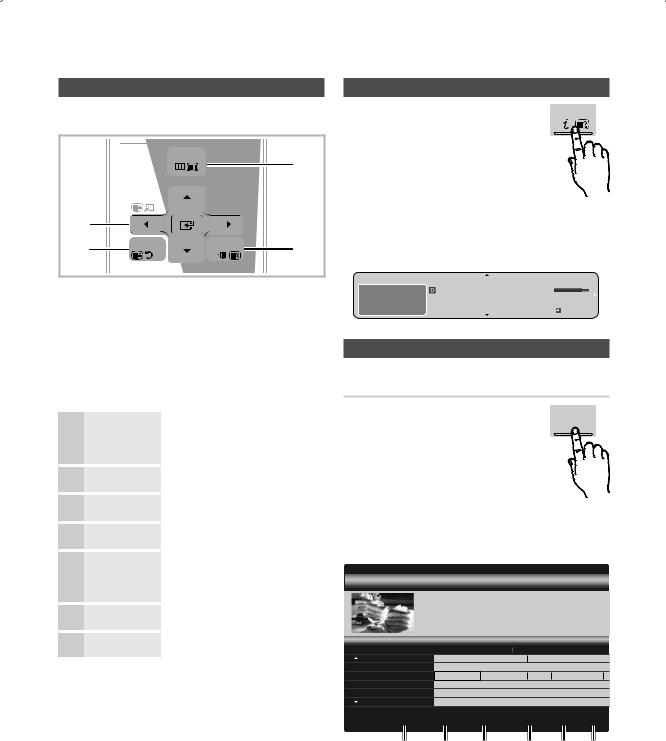
Basic Features
How to Navigate Menus
Before using the TV, follow the steps below to learn how to navigate the menu and select and adjust different functions.
|
|
|
|
|
|
|
MENU |
|
|
|
|
|
CONTENT |
|
|
|
3 |
||||
1 |
|
|
|
|
|
|
|
|
|
|
|
|
|
|
|
|
|
|
|
|
|
|
|
|
|
|
|
|
|
|
|
|
|
|
|
|
|
|
|
|
|
|
|
|
|
|
|
|
|
|
|
|
|
|
2 |
|
RETURN |
EXIT |
4 |
||||||
1ENTERE/ Direction button: Move the cursor and select an item. Confirm the setting.
2 RETURN button: Returns to the previous menu. 3 MENU button: Displays the main on-screen menu. 4 EXIT button: Exits the on-screen menu.
How to Operate the OSD (On Screen Display)
The access step may differ depending on the selected menu.
1 |
MENU m |
2 |
▲ / ▼ |
3 |
ENTER E |
4 |
▲ / ▼ |
5 |
◄ / ► |
6 |
ENTER E |
7 |
EXIT e |
The main menu options appear on the screen:
Picture, Sound, Channel, Setup, Input, Application, Support.
Select an icon with the ▲ or ▼ button.
Press ENTEREto access the sub-menu.
Select the desired submenu with the ▲ or ▼ button.
Adjust the value of an item with the ◄ or ► button. The adjustment in the OSD may differ depending on the selected menu.
Press ENTEREto complete the configuration.
Press EXIT.
Using the INFO button (Now & Next guide)
The display identifies the current channel |
INFO |
|
and the status of certain audio-video |
||
|
||
settings. |
|
The Now & Next guide shows daily TV programme information for each channel according to the broadcasting time.
yy Scroll ◄, ► to view information for a desired programme while watching the current channel.
yy Scroll ▲, ▼ to view information for other channels. If you want to move to the currently selected channel, press the ENTEREbutton.
DEF |
|
|
18:11 Thu 6 Jan |
DTV Air |
|
Life On Venus Avenue |
18:00 ~ 6:00 |
15 |
|
Unclassified |
E Watch |
|
No Detaild Information |
Information |
|
|
Planning Your Viewing |
||
Guide |
|
|
|
The EPG (Electronic Programme Guide) |
GUIDE |
||
information is provided by broadcasters. |
|||
Using programme schedules provided |
|
||
by broadcasters, you can specify |
|
||
programmes you want to watch in |
|
||
advance so that the channel automatically |
|||
changes to the selected programme |
|
||
channel at the specified time. Programme |
|
||
entries may appear blank or out of date depending on a |
|||
channel status. |
|
|
|
Using Channel View |
|
||
Guide |
|
|
2:10Tue 1 Jun |
|
DTV Air 800 five |
|
|
|
Home and Away |
|
|
|
18:00 - 18:30 |
|
|
|
Drama |
|
|
800 five |
Dani is devastated when scott makes clear his views on marriage... |
||
Channel View - TV |
18:00 - 19:00 |
19:00 - 20:00 |
|
Today |
|
||
27 |
Discovery |
American Chopper |
Tine Team |
28 |
DiscoveryH&L |
Programmes resume at 06:00 |
Fiv... )Dark Angel |
800 |
five |
Home and... )Family Affairs |
|
24 |
price-drop.tv |
No Information |
|
16 |
QVC |
QVC Selection |
|
6 |
R4DTT |
No Information |
|
 View Mode
View Mode  +24 Hours
+24 Hours  Ch. Mode
Ch. Mode  Information kPage E Watch
Information kPage E Watch
1 2 3 4 5 6
12 English
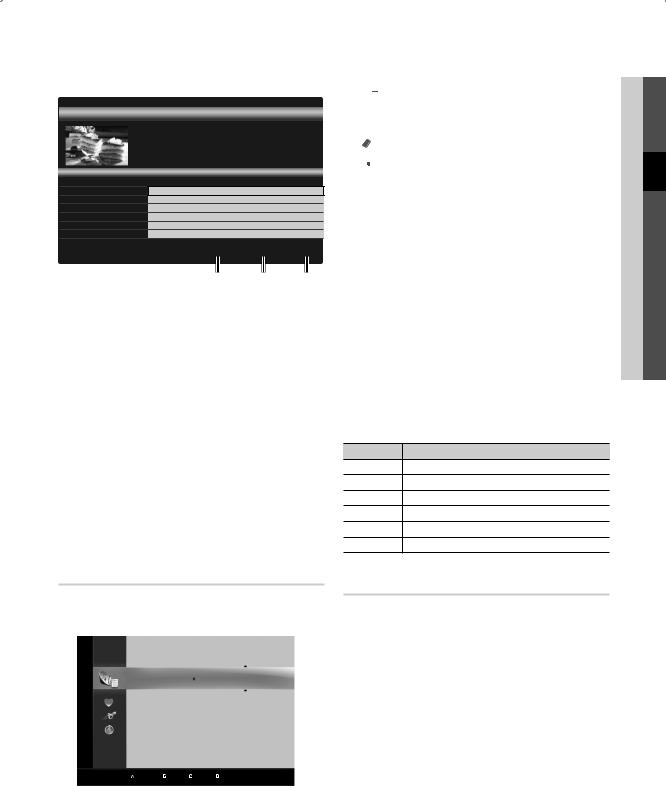
Using Scheduled View
Guide |
2:10Tue 1 Jun |
|
DTV Air 800 five |
|
Family Affairs |
|
18:00 - 18:30 |
|
Drama |
800 five |
Tanya confesses all to a stunned Babs. Conrad is anxious to hear... |
|
|
Scheduled View |
|
|
|
|
18:30 |
Today |
)Family Affairs |
800 |
five |
19:15 |
Today |
)Dark Angel |
800 |
five |
 View Mode
View Mode  Information E Cancel
Information E Cancel
1 4 6
1 Red (View Mode): View the list of programmes that are playing now or coming up.
Red (View Mode): View the list of programmes that are playing now or coming up.
2 Yellow (+24 Hours): Viewing the list of programmes to be broadcasted after 24 hours.
Yellow (+24 Hours): Viewing the list of programmes to be broadcasted after 24 hours.
3 Blue (Ch. Mode): Select the type of channels you want to display on the Channel View window.
Blue (Ch. Mode): Select the type of channels you want to display on the Channel View window.
––The Ch. Mode differs according to the antenna source.
4Information: Displays details of the selected programme.
5 k(Page): Move to next or previous page.
6ENTEREbutton
––When selecting the current programme, you can watch the selected programme.
––When selecting the future programme, you can reserve to watch the selected programme. To cancel the schedule, press the ENTEREbutton again and select Cancel Schedules.
■■ 
 Channels: Shows the channel list according to channel type.
Channels: Shows the channel list according to channel type.
■■ *My Channels: Shows the group of the channel.
■■  Satellite: Shows the channel list according to satellite signal.
Satellite: Shows the channel list according to satellite signal.
■■  Scheduled: Shows all the currently reserved programmes.
Scheduled: Shows all the currently reserved programmes.
Using the colour buttons with the Channel Manager
xx  Red (Antenna): Toggle among Air, Cable, Satellite or Canal Digital Sat.
Red (Antenna): Toggle among Air, Cable, Satellite or Canal Digital Sat.
xx  Green (Zoom): Enlarges or shrinks a channel number.
Green (Zoom): Enlarges or shrinks a channel number.
xx  Yellow (Select): Select desired channels and press the Yellow button to set all the selected channels at the same time. The cmark appears to the left of the selected channels.
Yellow (Select): Select desired channels and press the Yellow button to set all the selected channels at the same time. The cmark appears to the left of the selected channels.
xx  Blue (Sort): Change the list ordered by channel name or channel number.
Blue (Sort): Change the list ordered by channel name or channel number.
xx k(Page): Move to next or previous page.
xx T(Tools): Displays the Channel Manager option menu. (The options menus may differ depending on the situation.)
Channel Status Display Icons
Icons Operations
A An analogue channel.
cA channel selected.
*A channel set as a Favourite.
( A programme currently being broadcast.
\A locked channel.
)A reserved programme.
BasicFeatures03
Channel Manager
Delete or set favourites channels and use the programme guide for digital broadcasts. Select a channel in the
Channels, My Channels, Satellite or Scheduled screen.
|
|
|
|
|
c1 |
|
1futech |
|
Channels |
|
|
|
|
2 |
|
* 24ore.tv |
|
TV |
3 |
|
BBC World |
|||||
|
All |
15 |
|
abc1 |
||||
|
Radio |
23 |
|
bid-up.tv |
||||
|
Data/Other |
33 |
|
Boonerang |
||||
|
Free |
32 |
|
Cartoon Nwk |
||||
|
Scrambled |
5 |
|
Class News |
||||
|
Searched |
4 |
|
Coming Soon |
||||
|
|
|
|
|
27 |
|
Discovery |
|
Satellite |
|
Antenna |
|
Zoom |
|
Select |
|
Sort kPage T Tools |
|
|
|
|
|||||
Guide Type (Samsung / Guide Plus+)
(depending on the country)
You can select a different type of Guide.
■■ Samsung: Uses the guide programme by provided samsung.
■■ Guide Plus+: Uses the guide programme provided by Rovi International Solutions. For more information, refer to “www.europe.guideplus.com.”
English 13
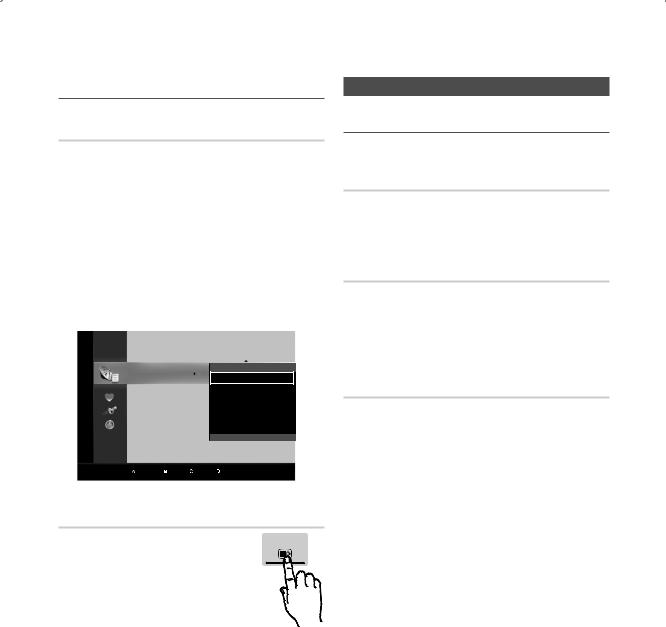
Basic Features
¦¦ Using Favourite Channels
* My Channels
(in Channel Manager) Shows all favourite channels.
■■ Edit My Channels t: You can set the selected channels to desired my channels group.
The “*” symbol will be displayed and the channel will be set as a my channel.
1.Select a channel and press the TOOLS button.
2.Add or delete a channel in the my channel groups you want among 1, 2, 3 and 4.
xx One or more groups can be selected.
3.After you have changed the settings, the channel list for each group can be viewed in my channels.
|
|
|
|
|
c1 |
|
|
|
1futech |
||
Channels |
|
|
|
|
2 |
|
|
|
|
* 24ore.tv |
|
TV |
3 |
|
|
|
|||||||
|
Lock |
BBC World |
|||||||||
|
All |
|
15Edit My |
abc1 |
|||||||
|
|
|
|
|
|
|
|
|
|
|
Channels |
|
Radio |
23 |
|
|
|
bid-up.tv |
|||||
|
Data/Other |
33 |
Timer Recording |
||||||||
|
|
|
|
Boonerang |
|||||||
|
|
|
|
|
|
|
|
Timer Viewing |
|||
|
Free |
|
|
|
Edit Channel Number |
||||||
|
|
32Delete |
Cartoon Nwk |
||||||||
|
Scrambled |
5 |
|
|
|
|
Class News |
||||
|
Searched |
4 |
|
|
|
|
d |
||||
|
|
|
|
|
Coming Soon |
||||||
|
|
|
|
|
27 |
|
|
|
Discovery |
||
Satellite |
|
Antenna |
|
Zoom |
|
Select |
|
|
Sort kPage T Tools |
||
|
|
|
|
||||||||
Channel List
You can see all the channels searched. CH LIST
14 English
Channel Menu
¦¦ Returning Channels
Antenna (Air / Cable / Satellite /
Canal Digital Sat)
Before your television can begin memorizing the available channels, you must specify the type of signal source that is connected to the TV (i.e. an Air, Cable, Satellite or Canal Digital Sat system).
Country
The PIN input screen appears. Enter your 4 digit PIN number.
■■ Digital Channel: Change the country for digital channels.
■■ Analogue Channel: Change the country for analogue channels.
Auto Store
Scans for a channel automatically and stores in the TV.
Automatically allocated programme numbers may not correspond to actual or desired programme numbers. If a channel is locked using the Child Lock function, the PIN input window appears.
■■ Antenna Source (Air / Cable / Satellite / Canal Digital Sat) t: Select the antenna source to memorise.
When Antenna Source is set to Air or Cable:
■■ Channel Source (Digital & Analogue / Digital / Analogue): Select the channel source to memorise.
When selecting Cable → Digital & Analogue or Digital: Provide a value to scan for cable channels.
Search Mode (Full / Network / Quick): Scans for all channels with active broadcast stations and stores them in the TV.
If you select Quick, you can set up the Network, Network ID, Frequency, Modulation, and
Symbol Rate manually by press the button on the remote control.
Network (Auto / Manual): Selects the Network ID setting mode among Auto or Manual.
Network ID: When Network is Manual, you can set up
Network ID using the numeric buttons.
Frequency: Displays the frequency for the channel. (differs in each country)
Modulation: Displays available modulation values. Symbol Rate: Displays available symbol rates.
■■ Cable Mode (Cable Network / SMATV Network)
(Norway only): Select the Cable mode to memorise.
This function is available when you have multiple network.

When Antenna Source is set to Satellite:
■■ Channel Type (All / TV / Radio): Select the Channel type to memorise.
■■ Satellite: Selects the satellite to scan.
■■ Scan Mode (All Channels / Free Channels Only): Selects the scanning mode of the selected satellite.
Manual Store
(Not available when Antenna Source is set to Canal Digital Sat)
Scans for a channel manually and stores in the TV.
If a channel is locked using the Child Lock function, the PIN input window appears.
When Antenna Source is set to Air or Cable:
■■ Digital Channel: When scanning has finished, channels are updated in the channel list.
When selecting Antenna → Air: Channel, Frequency, Bandwidth
When selecting Antenna → Cable: Frequency, Modulation, Symbol Rate
■■ Analogue Channel (Programme, Colour System, Sound System, Channel, Search): If there is abnormal sound or no sound, reselect the sound standard required.
Channel mode
xx P (programme mode): When tuning is complete, the broadcasting stations in your area have been assigned to position numbers from P0 to P99. You
can select a channel by entering the position number in this mode.
xx C (aerial channel mode) / S (cable channel mode): These two modes allow you to select a channel by entering the assigned number for each aerial broadcasting station or cable channel.
When Antenna Source is set to Satellite:
■■ Satellite: Selects the satellite using the up/down buttons.
■■ Transponder: Selects the transponder using the up/ down buttons.
■■ Scan Mode (All Channels / Free Channels Only): Selects either free or all channels to store.
■■ Network Search (Disable / Enable): Enable / Disable network search using the up/down buttons.
■■ Signal Quality: Display the current status of broadcasting signal.
Information on a satellite and its transponder is subject to change depending on the broadcasting conditions.
When setting is completed, move to Search and press the ENTEREbutton. Channel scan is started.
Satellite System Setup |
BasicFeatures03 |
|
|
|
|
The PIN input screen appears. Enter your 4 digit PIN number. |
|
|
Satellite System Setup is available when Antenna is set to |
|
|
Satellite or Canal Digital Sat. Before running Auto Store, |
|
|
Set Satellite System Setup. Then channel scan is run |
|
|
normally. |
|
|
|
|
|
■■ Satellite Selection: You can choose the satellites for |
|
|
this TV. |
|
|
This function is available when Antenna is set to |
|
|
Satellite. |
|
|
■■ LNB Power (Off / On): Enables or disables the power |
|
|
supply for the LNB. |
|
|
■■ LNB Settings: Configures the outdoor equipment. |
|
|
■■ Satellite: Selects the satellite for receiving digital |
|
|
broadcasts. |
|
|
Transponder: Selects a transponder from the list or |
|
|
adds a new transponder. |
|
|
DiSEqC Mode: Selects DiSEqC mode for the selected |
|
|
LNB. |
|
|
Lower LNB Oscillators: Sets the LNB oscillators to a |
|
|
lower frequency. |
|
|
Upper LNB Oscillators: Sets the LNB oscillators to a |
|
|
higher frequency. |
|
|
Tone 22 kHz (Off / On / Auto): Selects the Tone 22 |
|
|
kHz depending on the LNB type. For a universal LNB it |
|
|
should be Auto. |
|
|
Signal Quality: Display the current status of |
|
|
broadcasting signal. |
|
|
■■ Positioner Settings: Configures the antenna positioner. |
|
|
Positioner (On / Off): Enables or disables the positioned |
|
|
control. |
|
|
Positioner Type (USALS / DiSEqC 1.2): Sets |
|
|
the positioned type between DiSEqC 1.2 and |
|
|
USALS(Universal Satellite Automatic Location System). |
|
|
––My Longitude: Sets the longitude for my location.
––My Latitude: Sets the latitude for my location.
––Satellite Longitude Settings: Sets the longitude of user defined satellites.
User Mode: Sets the position of satellite antenna according to each satellite. If you store the current position of satellite antenna according to a certain satellite, when the signal of that satellite is needed, the satellite antenna can be moved to pre-populated position.
––Satellite: Selects the satellite to set the position for.
––Transponder: Selects a transponder from the list for signal reception.
––Moving Mode: Selects the movement mode between discrete and continuous movement.
––Step Size: Adjusts the step size degrees for the antenna rotation. Step Size is available when Moving Mode is set to Step.
English 15

Basic Features
––Go to Stored Position: Rotates the antenna to the stored satellite position.
––Antenna Position: Adjusts and stores the antenna position for the selected satellite.
––Store Current Position: Stores current position as the selected positioner limit.
––Signal Quality: Display the current status of broadcasting signal.
Installer Mode: Sets limits to the scope of movement of satellite antenna or reset the position. Generally, installation guide uses this function.
––Limit Position (East / West): Selects the direction of the positioner Limit.
––Antenna Position: Adjusts and stores the antenna position for the selected satellite.
––Store Current Position: Stores the current position as the selected positioner Limit.
––Go to Zero: Moves the antenna to the reference position.
––Reset Positioner Limit: Allows the antenna to rotate over the full arc.
■■ Reset All Setting (OK / Cancel): All satellite settings will be reset to the initial values.
¦¦ Editing Channels
Channel Manager Option Menu
(in Channel Manager)
1.Select a channel and press the TOOLS button.
2.Edit the channel name or number using the
Edit Channel Name or Edit Channel Number menu.
■■ Edit Channel Name (analogue channels only): Assign your own channel name.
■■ Edit Channel Number (digital channels only): Edit the number by pressing the number buttons desired.
¦¦ Other Features
Cable Search Option
(depending on the country)
Sets additional search options such as the frequency and symbol rate for a cable network search.
■■ Freq.Start / Freq.Stop: Set the start or stop frequency (differs in each country)
■■ Symbol Rate: Displays available symbol rates. ■■ Modulation: Displays available modulation values.
Channel Manager
Channel Manager Option Menu
Set each channel using the Channel Manager menu options (Lock / Unlock, Timer Recording, Timer Viewing, Sort, Reorder, Delete, Select All / Deselect All). Option menu items may differ depending on the channel status.
1.Select a channel and press the TOOLS button.
2.Select a function and change its settings.
■■ Lock / Unlock: Lock a channel so that the channel cannot be selected and viewed.
NOTE
xx This function is available only when the
Child Lock is set to On.
xx The PIN input screen appears. Enter your 4-digit PIN, the default of which is “0-0-0-0”. Change the PIN using the Change PIN option.
■■ Timer Recording (digital channels only): Allows you to record a programme currently being broadcasted or make a reservation to record a programme scheduled for broadcast.
A USB device with 4GB of memory or greater must be connected to the TV.
A USB storage device cannot record until it completes the Device Performance Test.
In case of USB-HDD, over 5400rpm
In case of USB Stick, USB 2.0 and SLC Type. (Minimum size of USB Stick is 2GB.)
■■ Timer Viewing: You can set a desired channel to be displayed automatically at the reserved time. Set the current time first to use this function.
When a digital channel is selected in
Channel Manager, press the ► button to view the digital Programme.
■■ Sort (analogue channels only): This operation allows you to change the programme numbers of the stored channels. This operation may be necessary after using the auto store.
■■ Reorder (when the Antenna was set to Satellite): Rearrange the channel manager in numerical order.
■■ Delete: You can delete a channel to display the channels you want.
■■ Select All / Deselect All: Select all the channels or deselect all the selected channels in the channel manager.
16 English

 Scheduled
Scheduled
(in Channel Manager)
You can view, modify or delete a show you have reserved to watch.
■■ Change Info: Change a show you have reserved to watch.
■■ Cancel Schedules: Cancel a show you have reserved to watch.
■■ Information: Display a show you have reserved to watch. (You can also change the reservation information.)
■■ Select All / Deselect All: Select or deselect all reserved programmes.
Channel List Transfer
The PIN input screen appears. Enter your 4 digit PIN number. Imports or exports the channel map. You should connect a USB storage to use this function.
■■ Import from USB: Import channel list from USB.
■■ Export to USB: Export channel list to USB. this function is available when USB is connected.
Edit Channel Number (Disable / Enable)
(digital channels only)
When this function is enable, you can edit channel number (p. 16). But you cannot update channel information automatically.
Fine Tune
(analogue channels only)
If the signal is weak or distorted, fine tune the channel manually.
Fine tuned channels are marked with an asterisk “*”.To reset the fine-tuning, select Reset.
Picture Menu
¦¦ Changing the Preset Picture Mode
Mode t
Select your preferred picture type.
■■ Dynamic: Suitable for a bright room.
■■ Standard: Suitable for a normal environment. ■■ Natural: Suitable for reducing eye strain.
Natural is not available in PC mode.
■■ Movie: Suitable for watching movies in a dark room.
¦¦ Adjusting Picture Settings
Backlight / Contrast / Brightness / Sharpness / Colour / Tint (G/R)
Your television has several setting options for picture quality control.
NOTE
xx In analogue TV, Ext., AV modes of the PAL system, the Tint (G/R) function is not available.
xx In PC mode, you can only make changes to
Backlight, Contrast and Brightness.
xx Settings can be adjusted and stored for each external device connected to the TV.
¦¦ Economical Solutions
Eco Solution
■■ Energy Saving (Off / Low / Medium / High / Picture Off / Auto) t: Adjust the brightness of the TV in order to reduce power consumption. If you select Picture Off, the screen is turned off, but the sound remains on. Press any button except volume button to turn on the screen.
■■ Eco Sensor (Off / On): To enhance your power savings; the picture settings will automatically adapt to the light in the room.
If you adjust the Backlight, the Eco Sensor will be set to Off.
Min Backlight: When Eco sensor is On, the minimum screen brightness can be adjusted manually.
If Eco Sensor is On, the display brightness may change (become slightly darker or brighter) depending on the surrounding light intensity.
■■ No-Signal Power Off (Off / 15 min / 30 min / 60 min): To avoid unnecessary energy consumption, set how long you want the TV to remain on if it’s not receiving a signal.
Disabled when the PC is in power saving mode.
English 17
BasicFeatures03

Basic Features
¦¦ Changing the Picture Options
Advanced Settings
(available in Standard / Movie mode)
You can adjust the detailed setting for the screen including colour and contrast.
In PC mode, you can only make changes to
Dynamic Contrast, Gamma, White Balance and LED Motion Plus.
Advanced Settings
Black Tone |
: Off |
► |
Dynamic Contrast |
: Medium |
|
Gamma |
: 0 |
|
Expert Pattern |
: Off |
|
RGB Only Mode |
: Off |
|
Colour Space |
: Native |
|
White Balance |
|
|
|
▼ |
|
|
UMove |
E Enter R Return |
■■ Black Tone (Off / Dark / Darker / Darkest): Select the black level to adjust the screen depth.
■■ Dynamic Contrast (Off / Low / Medium / High): Adjust the screen contrast.
■■ Gamma: Adjust the primary colour intensity.
■■ Expert Pattern (Off / Pattern1 / Pattern2): By running the Expert Pattern function, the picture can be calibrated without a generator or filter. If the OSD menu disappears or a menu other than the Picture menu is opened, the calibration is saved and the Expert Pattern window disappears.
While the Expert Pattern is running, sound is not outputted.
Only enabled in DTV, Component and HDMI modes.
■■ RGB Only Mode (Off / Red / Green / Blue): You can adjust Colour or Tint (G/R) of Red, Green or Blue for the picture from an external device (DVD player, home theatre, etc.).
■■ Colour Space (Auto / Native / Custom): Adjust the range of colours available to create the image. To adjust
Colour, Red, Green, Blue and Reset, set Colour Space to Custom.
■■ White Balance: Adjust the colour temperature for a more natural picture.
R-Offset / G-Offset / B-Offset: Adjust each colour’s (red, green, blue) darkness.
R-Gain / G-Gain / B-Gain : Adjust each colour’s (red, green, blue) brightness.
Reset: Resets the White Balance to it’s default settings.
■■ 10p White Balance (Off / On): Controls the white balance in 10 point interval by adjusting the red, green, and blue brightness.
Available when the picture mode is set to Movie and when the external input is set to HDMI or Component.
Some external devices may not support this function.
Interval: Select interval to adjust. Red: Adjust the red level. Green: Adjust the green level. Blue: Adjust the blue level.
Reset: Resets the 10p White Balance to its default settings.
■■ Flesh Tone: Emphasize pink “Flesh Tone.”
■■ Edge Enhancement (Off / On): Emphasize object boundaries.
■■ xvYCC (Off / On): Setting the xvYCC mode on increases detail and colour space when watching movies from an external device (e.g. DVD player) connected to the HDMI or Component IN jacks.
Available when the picture mode is set to Movie and when the external input is set to HDMI or Component.
Some external devices may not support this function.
■■ LED Motion Plus (Off / Normal / Cinema / Ticker): Removes drag from fast scenes with a lot of movement to provide a clear picture.
18 English
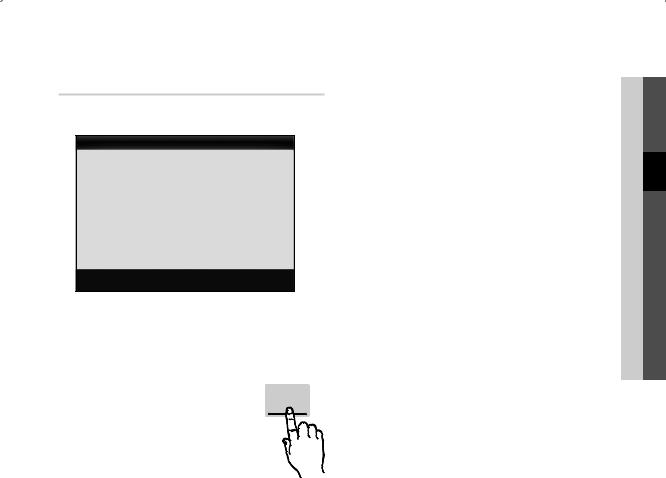
Picture Options
In PC mode, you can only make changes to the
Colour Tone, Size and Auto Protection Time.
Picture Options
Colour Tone |
: Normal |
► |
Size |
:Auto Wide |
|
Screen Mode |
: 16:9 |
|
Digital Noise Filter |
:Auto |
|
MPEG Noise Filter |
:Auto |
|
HDMI Black Level |
: Normal |
|
Film Mode |
: Off |
|
|
▼ |
|
|
UMove E Enter |
R Return |
■■ Colour Tone (Cool / Normal / Warm1 / Warm2)
Warm1 or Warm2 will be deactivated when the picture mode is Dynamic.
Settings can be adjusted and stored for each external device connected to an input on the TV.
■■ Size : Your cable box/satellite receiver |
P.SIZE |
may have its own set of screen sizes as |
|
well. However, we highly recommend you |
|
use 16:9 mode most of the time. |
|
Auto Wide: Automatically adjusts the picture size to the 16:9 aspect ratio.
16:9 : Adjusts the picture size to 16:9 for DVDs or wide broadcasting.
Wide Zoom: Magnifies the picture size more than 4:3.Adjusts the Position by using ▲, ▼ buttons.
Zoom: Magnifies the 16:9 wide pictures vertically to fit the screen size.
Adjusts the Position or Size by using ▲, ▼ button.
4:3 : The default setting for a movie or normal broadcasting.
Do not watch in 4:3 format for a long time. Traces of borders displayed on the left, right and centre of the screen may cause image retention(screen burn) which are not covered by the warranty.
Screen Fit: Displays the full image without any cut-off when HDMI (720p / 1080i / 1080p) or Component (1080i / 1080p) signals are inputted.
NOTE
xx When Double (À, Œ) mode has been set in PIP, the Picture Size cannot be set.
xx Depending on the input source, the picture size options may vary.
xx The available items may differ depending on the selected mode.
xx In PC mode, only 16:9 and 4:3 modes can be adjusted.
xx Settings can be adjusted and stored for each external device connected to an input of the TV.
xx After selecting Screen Fit in HDMI (1080i / 1080p) or Component (1080i / 1080p) mode: Adjusts the Position or Size by using ▲, ▼, ◄, ► button.
xx If you use the Screen Fit function with HDMI 720p input, 1 line will be cut at the top, bottom, left and right as in the overscan function.
■■ Screen Mode (16:9 / Wide Zoom / Zoom / 4:3): Available only when picture size is set to Auto Wide. You can determine the desired picture size at the 4:3 WSS (Wide Screen Service) size or the original size. Each European country requires different picture size.
Not available in PC, Component or HDMI mode.
■■ Digital Noise Filter (Off / Low / Medium / High / Auto / Auto Visualisation): When the broadcast signal is weak, some static and ghosting may appear. Select one of the options until the best picture is displayed.
Auto Visualisation: When changing analogue channels, displays the intensity of the current signal and defines the screen noise filter.
Only available for analogue channels.
■■ MPEG Noise Filter (Off / Low / Medium / High / Auto): Reduces MPEG noise to provide improved picture quality.
■■ HDMI Black Level (Normal / Low): Selects the black level on the screen to adjust the screen depth.
Available only in HDMI mode (RGB signals).
■■ Film Mode (Off / Auto1 / Auto2): Sets the TV to automatically sense and process film signals from all sources and adjust the picture for optimum quality.
Available in TV, AV, COMPONENT (480i / 1080i) and HDMI (480i / 1080i).
BasicFeatures03
English 19

Basic Features
■■ Motion Plus (Off / Clear / Standard / Smooth / Custom / Demo): Removes drag from fast scenes with a lot of movement to provide a clearer picture.
If noise occurs on the screen, please set up the
Motion Plus to Off. If Motion Plus is Custom, you can set up the Blur Reduction, Judder Reduction or Reset manually.
If Motion Plus is Demo, you can compare the difference of on and off modes.
Blur Reduction: Adjusts the blur reduction level from video sources.
Judder Reduction: Adjusts the judder reduction level from video sources when playing films.
Reset: Reset the custom settings.
■■ Auto Protection Time (2 hours / 4 hours / 8 hours / 10 hours / Off): If the screen remains idle with a still image for a certain period of time defined by the user,
the screen saver is activated to prevent the formation of ghost images on the screen.
■■ Smart LED (Off / Low / Standard / High / Demo): Controls LED backlight to maximize picture clarity. Demo: Displays the difference between Smart LED on and off modes.
¦¦ Viewing TV using the 3D function
IMPORTANT SAFETY INFORMATION. READ THE FOLLOWING WARNINGS BEFORE YOU OR YOUR CHILD USE THE 3D FUNCTION
[[WARNING
xx As the TV turns on, the left and right sides of 3D pictures may overlap more than usual. It may take time until the picture quality is optimized.
xx The 3D effect may be experienced differently depending on the viewer. You may not notice the 3D effect at all if you have a prescription for one eye that is very different from the other eye.
xx Parents’ careful supervision is required particularly when children or teenagers view 3D images.
xx Photosensitive Seizure Warning and Other Health Risks
––Some viewers may experience an epileptic seizure or stroke when exposed to certain flashing images or lights contained in certain television pictures or video games. If you or any of your relatives has a history of epilepsy or strokes, please consult with a medical specialist before using the 3D function.
––Even those without a personal or family history of epilepsy or stroke may have an undiagnosed condition that can cause “photosensitive epileptic seizures.”
––Do not watch 3D pictures when you feel incoherent, sleepy, tired or sick. Avoid watching 3D pictures for long hours.
20 English
––If you experience any of the following symptoms immediately stop watching 3D pictures and consult a medical specialist: (1) altered vision; (2) lightheadedness; (3) dizziness; (4) involuntary movements such as eye or muscle twitching;
(5)confusion; (6) nausea; (7) loss of awareness;
(8)convulsions; (9) cramps; and/or (10) disorientation. Parents should monitor and ask their children about the above symptoms-children and teenagers may be more likely than adults to experience these symptoms.
xx Note that watching TV while sitting too close to the screen for an extended period of time may weaken your eyesight.
xx Note that watching TV while wearing 3D Active Glasses for an extended period of time may cause a headache or fatigue. If you feel headache, fatigue or dizziness, stop watching TV and rest.
xx Some 3D pictures may startle viewers. The pregnant, elderly, epileptic and those suffering from serious physical conditions are advised to avoid utilizing the unit’s 3D functionality.
xx We don’t recommend 3D pictures to those who are in bad physical condition, who are sleep-deprived or who drank liquor.
xx Please take care to be aware of the world around you. This product is designed to be immersive. DO NOT use this product near open stairwells, cables, balconies, or other objects that can be tripped over, run into, knocked down, broken or fallen over. Being startled or deluding yourself into thinking that the 3D images are real may cause you to crush a nearby object or get injured trying to move your body.
xx Do not use the 3D Active Glasses for any other purpose than for which it was designed. Wearing the with an HDMI/DVI for any other purpose (as general spectacles, sunglasses, protective goggles, etc.) may physically harm you or weaken your eyesight.
xx Immersive video can potentially have adverse effects on the user including motion sickness, perceptual after effects, disorientation, eye strain, and decreased postural stability. Take frequent breaks to lessen the potential of these effects, as is commonly suggested for other items, such as keyboards and computer monitors, that you may tend to fixate or concentrate on. If your eyes show signs of fatigue or dryness or if you have any of the above symptoms, immediately discontinue use of this device and do not resume using it for at least thirty minutes after the symptoms have subsided.
xx The ideal viewing distance should be three times or more the height of the screen. We recommend sitting with viewer’s eyes on a level with the screen.

3D
This exciting new feature enables you to |
3D |
view 3D content. In order to fully enjoy |
this feature, you must purchase a pair of Samsung 3D Active Glasses (SSG2100AB, SSG-2200AR, SSG-2200KR) to view 3D video.
Samsung 3D Active Glasses are sold separately. For more detailed purchasing
information, contact the retailer where you purchased this TV.
3D emitter
If there is any obstacle between the emitter and 3D Active Glasses, the proper 3D effect may not be obtained.
■■ 3D Mode: Select the 3D input format.
If you want to feel the 3D effect fully, please wear the 3D Active Glasses first, and then select
3D mode from the list below that provides the best 3D viewing experience.
When watching 3D images, turn on 3D Active Glasses.
3D Mode |
Operation |
|
|
|
|
Off |
Turns the 3D function off. |
|
|
2D → 3D |
Changes a 2D image to 3D. |
|
|
|
|
Side by Side |
Displays two images next to |
|
each other. |
|
|
|
|
|
Top & Bottom |
Displays one image above |
|
another. |
|
|
|
|
|
Line by Line |
Displays the images for the left |
|
and right eye alternately in rows. |
|
|
|
|
|
|
Displays the images for the |
|
Vertical Stripe |
left and right eye alternately in |
|
|
columns. |
|
Checker |
Displays the images for the |
|
left and right eye alternately in |
|
|
Board |
|
|
pixels. |
|
|
|
|
|
|
Displays the images for the |
|
Frequency |
left and right eye alternately in |
|
|
frames. |
“Side by Side” and “Top & Bottom” are available when the resolution is 720p, 1080i and 1080p in DTV, HDMI and USB mode or set to PC connecting through HDMI/DVI cable.
“Vertical Strip”, “Line by Line” and “Checker Board” are available when the resolution is set to PC connecting through HDMI/DVI cable.
“Frequency” displays the frequency (60Hz only) when the resolution is set to PC.
■■ 3D → 2D (Off / On): Displays the image for the left eye only.
This function is deactivated when 3D Mode set to “2D → 3D” or Off.
■■ 3D View point: The overall adjustment of 3D perspective.
This function is deactivated when 3D Mode set to “2D → 3D” or Off.
■■ Depth: Adjusts focus / depth in “2D → 3D” mode.
This function is only activated when the 3D Mode is “2D → 3D”.
■■ Picture Correction: Adjusts the images for the left and right eye.
■■ 3D Auto View (Off / On): If 3D Auto View is set to On, a “Side-By-Side” format HDMI signal with one of the resolutions below is automatically switched to 3D. Here, correct 3D information must be sent from the HDMI 1.3 transmitter.
If a 3D failure occurs due to a 3D information error, set 3D Auto View to Off and manually select a 3D Mode using the 3D button or corresponding menu.
Support resolution (16:9 only)
Resolution |
Frequency (Hz) |
||
1280 x 720p |
50 |
/ 60 |
Hz |
1920 x 1080i |
50 |
/ 60 |
Hz |
1920 x 1080p |
24 / 30 |
/ 50 |
/ 60 Hz |
Resolution supported for HDMI PC mode
The resolution for HDMI PC mode is optimized to 1920 x 1080 input.
An input resolution other than 1920 x 1080 may not be displayed properly in 3D display or full screen mode.
BasicFeatures03
English 21

Basic Features
How to watch the 3D image
3D


 To watch in 3D, wear 3D glasses and press the power button on the glasses. Viewing 3D TV motion pictures for long periods may cause eye fatigue and/or dizziness.
To watch in 3D, wear 3D glasses and press the power button on the glasses. Viewing 3D TV motion pictures for long periods may cause eye fatigue and/or dizziness.
OK Cancel
UMove E Enter e Exit
3D
UsiingttheLEFT//RIIGHTkeysonttherremotecontrol, sellecttttheiiconsuitablefforrtthepiicttureonscrreen..
UMove EEnterr eExit
1.Press the CONTENT button, then the Content View menu will appear.
2.Press the ◄ or ► button, then select 3D.
To watch in 3D, wear 3D Active Glasses and press the power button on the glasses.
3.Select OK, then press the ENTEREbutton.
4.Using the ◄ or ► buttons on your remote control, selects the 3D Mode of the image you want to view.
Some 3D modes may not be available depending
on the format of the image source.
Supported formats and operating specifications for HDMI 1.4
Source signal format |
Standard HDMI 1.4 3D |
1920x1080p@24Hz x 2 |
1920x2205p@24Hz |
|
|
1280x720p@60Hz x 2 |
1280x1470p@60Hz |
|
|
1280x720p@50Hz x 2 |
1280x1470p@50Hz |
The mode is automatically switched to 3D mode for the 3D video input in one of the formats above.
For the HDMI 1.4@24Hz format, the TV is optimized as follows:
––Resolution First Display Mode: If Motion Plus is set to Off, Clear or Standard, you can watch the video at a high resolution optimized to the resolution of the source video.
––Judder Reduction Display Mode: When
Motion Plus is set to Smooth or Custom, you can watch a smooth picture without judder.
Before using 3D function...
NOTE
xx You may notice a small amount of screen flickering when watching 3D images in poor light conditions (from a strobe light, etc.), or under a fluorescent lamp (50Hz ~ 60Hz) or 3 wavelength lamp. If so, dim the light or turn the lamp off.
xx 3D mode is automatically disabled in following cases: when changing a channel or the input source, or accessing Media Play or Internet@TV.
xx Some Picture functions are disabled in 3D mode.
xx PIP and data broadcast is not supported in 3D mode.
xx Data broadcasts (MHEG / MHP) are not supported in 3D mode.
xx 3D Active Glasses from other manufacturers may not be supported.
xx When the TV is initially powered on, may take some time until the 3D display is optimized.
xx The 3D Active Glasses may not work properly if there is any other 3D product or electronic devices turned on near the glasses or TV. If there is a problem, keep other electronic devices as far away as possible from the 3D Active Glasses.
xx When watching pictures from a 50Hz 3D source with its Game mode On, visually-sensitive viewers may see some flicker on bright images.
xx Photos of Media Play are shown in “2D → 3D” mode only.
xx If lying on your side, the 3D-effects may not be displayed.
xx Be sure to stay within the viewing angle and optimum TV viewing distance when watching 3D pictures.
––Otherwise, you may not be able to enjoy proper 3D effects.
22 English

Picture Reset (OK / Cancel)
Resets your current picture mode to its default settings.
¦¦ Setting up the TV with Your PC
Set the input source to PC.
Auto Adjustment t
Adjust frequency values/positions and fine tune the settings automatically.
Not available when connecting with an HDMI/DVI cable.
Screen
■■ Coarse / Fine: Removes or reduces picture noise. If the noise is not removed by Fine-tuning alone, then adjust the frequency as best as possible (Coarse) and Finetune again. After the noise has been reduced, readjust the picture so that it is aligned to the centre of screen.
■■ Position: Adjust the PC screen position with direction button (▲ / ▼ / ◄ / ►).
■■ Image Reset: Resets the image to default settings.
Using Your TV as a Computer (PC) Display
Setting Up Your PC Software (Based on Windows XP)
Depending on the version of Windows and the video card, the actual screens on your PC may differ in which case the same basic set-up information will almost always be applied. (If not, contact your computer manufacturer or Samsung Dealer.)
1.Click on “Control Panel” on the Windows start menu.
2.Click on “Appearance and Themes” in the “Control Panel” window and a display dialog-box will appear.
3.Click on “Display” and a display dialog box will appear.
4.Navigate to the “Settings” tab on the display dialog-box.
yy The correct size setting (resolution) [Optimum: 1920 X 1080 pixels]
yy If a vertical-frequency option exists on your display settings dialog box, the correct value is “60” or “60 Hz”. Otherwise, just click “OK” and exit the dialog box.
Sound Menu
¦¦ Changing the Preset Sound Mode
SRS TheaterSound t
■■ Standard: Selects the normal sound mode. ■■ Music: Emphasizes music over voices.
■■ Movie: Provides the best sound for movies.
■■ Clear Voice: Emphasizes voices over other sounds.
■■ Amplify: Increase the intensity of high-frequency sound to allow a better listening experience for the hearing impaired.
¦¦ Adjusting Sound Settings
Equalizer
Adjusts the sound mode (standard sound mode only).
■■ Balance L/R: Adjusts the balance between the right and left speaker.
■■ 100Hz / 300Hz / 1kHz / 3kHz / 10kHz (Bandwidth Adjustment): Adjusts the level of specific bandwidth frequencies.
■■ Reset: Resets the equalizer to its default settings.
¦¦ Sound Systems, Etc.
SRS TruSurround HD (Off / On) t
(standard sound mode only)
This function provides a virtual 5.1 channel surround sound experience through a pair of speakers using HRTF (Head Related Transfer Function) technology.
SRS TruDialog (Off / On)
(standard sound mode only)
This function allows you to increase the intensity of a voice over background music or sound effects so that dialog can be heard more clearly.
BasicFeatures03
English 23

Basic Features
Audio Language
(digital channels only)
Change the default value for audio languages.
The available language may differ depending on the broadcast.
Audio Format
(digital channels only)
When sound is emitted from both the main speaker and the audio receiver, a sound echo may occur due to the decoding speed difference between the main speaker and the audio receiver. In this case, use the TV Speaker function.
Audio Format option may differ depending on the broadcast. 5.1ch Dolby digital sound is only available when connecting an external speaker through an optical cable.
Audio Description
(not available in all locations) (digital |
AD |
channels only) |
|
This function handles the Audio Stream |
|
for the AD (Audio Description) which is |
|
sent along with the Main audio from the |
|
broadcaster. |
|
■■ Audio Description (Off / On): Turn |
|
the audio description function on or |
|
off. |
|
■■ Volume: Adjust the audio description volume.
Auto Volume (Off / Normal / Night)
To equalize the volume level on each channel, set to Normal.
■■ Night: This mode provides an improved sound experience compared to Normal mode, making almost no noise. It is useful at night.
Speaker Select (External Speaker /
TV Speaker)
A sound echo may occur due to a difference in decoding speed between the main speaker and the audio receiver. In this case, set the TV to External Speaker.
When Speaker Select is set to External Speaker, the volume and MUTE buttons will not operate and the sound settings will be limited.
When Speaker Select is set to External Speaker xx TV Speaker: Off, External Speaker: On
When Speaker Select is set to TV Speaker xx TV Speaker: On, External Speaker: On
If there is no video signal, both speakers will be mute.
Additional Setting
(digital channels only)
■■ DTV Audio Level (MPEG / HE-AAC): This function allows you to reduce the disparity of a voice signal (which is one of the signals received during a digital TV broadcast) to a desired level.
According to the type of broadcast signal, MPEG / HE-AAC can be adjusted between -10dB and 0dB.
To increase or decrease the volume, adjust between the range 0 and -10 respectively.
■■ SPDIF Output: SPDIF (Sony Philips Digital InterFace) is used to provide digital sound, reducing interference going to speakers and various digital devices such as a DVD player.
Audio Format: During the reception of a digital TV broadcast, you can select the Digital Audio output (SPDIF) format from the options PCM or Dolby Digital.
Audio Delay: Correct audio-video sync problems, when watching TV or video, and when listening to digital audio output using an external device such as an AV receiver (0ms ~ 250ms).
■■ Dolby Digital Comp (Line / RF): This function minimizes signal disparity between a dolby digital signal and a voice signal (i.e. MPEG Audio, HE-AAC, ATV Sound).
Select Line to obtain dynamic sound, and RF to reduce the difference between loud and soft sounds at night time.
Line: Set the output level for signals greater or less than -31dB (reference) to either -20dB or -31dB.
RF: Set the output level for signals greater or less than -20dB (reference) to either -10dB or -20dB.
24 English

Sound Reset (OK / Cancel)
Reset all sound settings to the factory defaults.
¦¦ Selecting the Sound Mode t
When you set to Dual f-g, the current sound mode is displayed on the screen.
|
Audio |
Dual f-g |
Default |
|
|
Type |
|||
|
|
|
||
A2 |
Mono |
Mono |
Automatic |
|
Stereo |
Stereo ↔ Mono |
change |
||
Stereo |
||||
Dual |
Dual f↔ Dual g |
Dual f |
||
|
||||
|
Mono |
Mono |
Automatic |
|
NICAM |
Stereo |
Mono ↔ Stereo |
change |
|
Stereo |
Dual |
Mono ↔ Dual f |
Dual f |
|
|
Dual g |
|||
|
|
|
If the stereo signal is weak and an automatic switching occurs, then switch to the mono.
Only activated in stereo sound signal.
Only available when the Input source is set to TV.
Setup Menu
¦¦ Setting the Time
Time
■■ Clock: Setting the clock is for using various timer features of the TV.
OO The current time will appear every time you press the INFO button.
If you disconnect the power cord, you have to set the clock again.
Clock Mode (Auto / Manual)
Depending on the broadcast station and signal, the auto time set up may not be correct. In this case, set the time manually.
The antenna must be connected in order to set the time automatically.
Clock Set: Set the Day, Month, Year, Hour and Minute manually.
Available only when Clock Mode is set to
Manual.
Time Zone (depending on the country): Select your time zone.
When Country is set to Others, you can use this function.
This function is only available when the
Clock Mode is set to Auto.
¦¦ Using the Sleep Timer |
|
|
|
|
|
|
|
|
|
BasicFeatures03 |
|
|||||||||||||||
|
|
|
|
|
|
|
|
|
|
|
||||||||||||||||
■■ Sleep Timer t: Automatically shuts off the TV |
|
|
||||||||||||||||||||||||
|
after a preset period of time. (30, 60, 90, 120, 150 and |
|
|
|||||||||||||||||||||||
|
180 minutes). |
|
|
|
|
|
|
|
|
|
|
|
|
|
|
|
|
|
|
|||||||
|
To cancel Sleep Timer, select Off. |
|
|
|
|
|
|
|
||||||||||||||||||
|
|
|
|
|
|
|
||||||||||||||||||||
¦¦ Setting the On / Off Timer |
|
|
|
|
|
|
|
|
|
|
|
|||||||||||||||
|
|
|
|
|
|
|
|
|
|
|
|
|
|
|
|
|
|
|
|
|
|
|
|
|
|
|
■■ Timer 1 / Timer 2 / Timer 3: Three different on / off |
|
|
||||||||||||||||||||||||
|
timer settings can be made. You must set the clock first. |
|
|
|||||||||||||||||||||||
|
|
|
|
|
|
|
|
|
|
|
|
|
|
|
|
|
|
|
|
|
|
|
|
|
|
|
|
|
|
|
|
|
|
|
|
Timer 1 |
|
|
|
|
|
|
|
|
|
|
|
||||||
|
|
On Time |
|
|
|
|
|
|
|
|
|
|
|
|
|
|
|
|
|
|
|
|
|
|
|
|
|
|
▲ |
|
|
|
|
|
|
00 |
|
|
|
|
00 |
|
|
|
|
|
|
|
|||||
|
|
Inactivate |
|
|
|
|
|
|
|
|
|
|
|
|
|
|
|
|
|
|||||||
|
|
▼ |
|
|
|
|
|
|
|
|
|
|
|
|
|
|
|
|
|
|
|
|
|
|
|
|
|
|
Off Time |
|
|
|
|
|
|
|
|
|
|
|
|
|
|
|
|
|
|
|
|
|
|
|
|
|
|
Inactivate |
|
|
|
|
|
|
00 |
|
|
|
|
00 |
|
|
|
|
|
|
|
|||||
|
|
Volume |
|
Source |
|
|
|
Antenna |
|
|
Channel |
|
|
|
||||||||||||
|
|
10 |
|
|
|
|
|
TV |
|
|
|
|
ATV |
|
|
1 |
|
|
|
|
|
|
||||
|
|
|
|
|
|
|
|
|
|
|
|
|
|
|
|
|
|
|
|
|
|
|
|
|
|
|
|
|
Repeat |
|
|
|
Sun |
Mon Tue |
Wed |
|
Thu Fri |
|
Sat |
|
|
|
|||||||||||
|
|
Once |
|
|
|
|
|
|
|
|
||||||||||||||||
|
|
|
|
|
|
|
|
|
|
|
|
|
|
|
|
|
|
|
|
|
|
|
|
|
|
|
|
|
|
|
|
|
|
|
|
LMove |
U Adjust |
E Enter |
R Return |
|
|
|
|||||||||||
|
|
|
|
|
|
|
|
|
|
|
|
|
|
|
|
|
|
|
|
|
|
|
|
|
|
|
On Time / Off Time: Set the hour, minute, and activate / inactivate. (To activate timer with the setting you’ve chosen, set to Activate.)
Volume: Set the desired volume level.
Source: Select TV or USB content to be played when the TV is turned on automatically. (USB can be selected only when a USB device is connected to the TV)
Antenna (when the Source is set to TV): Select ATV or
DTV.
Channel (when the Source is set to TV): Select the desired channel.
Contents (when the Source is set to USB): Select a folder in the USB device containing music or photo files
to be played when the TV is turned on automatically.
NOTE
xx If there is no music file on the USB device or the folder containing a music file is not selected, the Timer function does not operate correctly.
xx When there is only one photo file in the USB device, the Slide Show will not play.
xx If a folder name is too long, the folder cannot be selected.
xx Each USB you use is assigned its own folder. When using more than one of the same type of USB, make sure the folders assigned to each USB have different names.
English 25

Basic Features
Repeat: Select Once, Everyday, Mon~Fri, Mon~Sat, Sat~Sun or Manual to set at you convenience. If you select Manual, you can set up the day you want to activate the timer.
The cmark indicates the day is selected.
Auto Power Off (available only when the TV is turned on by Timer): The TV will be automatically turned off after 3 hours of being left idle to prevent overheating.
¦¦ Locking Programmes
Security
The PIN input screen appears before the setup screen.
Enter your 4-digit PIN, the default of which is “0-0-0-0”. Change the PIN using the Change PIN option.
■■ Child Lock (Off / On): Lock channels in Channel Manager, to prevent unauthorized users, such as children, from watching unsuitable programme.
Available only when the Input source is set to TV.
■■ Parental Lock (depending on the country): Prevent unauthorized users, such as children, from watching unsuitable programme with a user-defined 4-digit PIN code. If selected channel is locked, the “\” symbol will be displayed.
Allow All: Unlock All TV ratings (Not supported in Sweden).
You can block TV programs by set up rating in Parental Lock as the Children, Youth or Adult (Sweden only).
■■ Change PIN: Change your personal ID number required to set up the TV.
If you forget the PIN code, press the remote control buttons in the following sequence, which resets the PIN to “0-0-0-0”: POWER (off) →
MUTE → 8 → 2 → 4 → POWER (on).
¦¦ Other Features
Language
■■ Menu Language: Set the menu language.
■■ Teletext Language: Set a desired language for teletext.
English is the default in cases where the selected language is unavailable in the broadcast.
■■ Preference (Primary Audio Language / Secondary Audio Language / Primary Subtitle Language / Secondary Subtitle Language / Primary Teletext Language / Secondary Teletext
Language): Select a language, which will be the default language when a channel is selected.
26 English
Subtitle
Use this menu to set the Subtitle mode.
■■ Subtitle (Off / On): Switches subtitles on or off.
■■ Mode (Normal / Hearing Impaired): Sets the subtitle mode.
■■ Subtitle Language: Sets the subtitle language.
If the programme you are watching does not support the Hearing Impaired function, Normal automatically activates even if the
Hearing Impaired mode is selected.
English is the default in cases where the selected language is unavailable in the broadcast.
Network (Network Type / Network Setup / Network Test / SWL(Samsung Wireless Link) / SWL connect)
For details on set up options, refer to the “Network Connection” instructions (p. 30).
General
■■ Game Mode (Off / On): When connecting to a game console such as PlayStation™ or Xbox™, you can enjoy a more realistic gaming experience by selecting game mode.
NOTE
xx Precautions and limitations for game mode
––To disconnect the game console and connect another external device, set Game Mode to Off in the setup menu.
––If you display the TV menu in Game Mode, the screen shakes slightly.
xx Game Mode is not available when the input source is set to TV or PC.
xx After connecting the game console, set Game Mode to On. Unfortunately, you may notice reduced picture quality.
xx If Game Mode is On:
––Picture mode is set to Standard and Sound mode is set to Movie.
––Equalizer is not available.

■■ BD Wise (Off / On): Provides the optimal picture quality for Samsung DVD, Blu-ray and Home Theatre products which support BD Wise. When BD Wise is turned On, the picture mode is automatically changed to the optimal resolution.
Available when connecting Samsung products that support BD Wise through a HDMI cable.
■■ Menu Transparency (Bright / Dark): Se t the Transparency of the menu.
■■ Melody (Off / Low / Medium / High): Set so that a melody plays when the TV is turned on or off.
Melody is disabled when FastStart is On.
■■ FastStart (Off / On): When the TV is powered on, the screen will come on quickly with this feature.
■■ Light Effect (Off / In Standby / Watching TV / Always): You can turn the LED on/off on the front of TV. Turn it off to save power or if the LED is too bright for you.
Set the Light Effect to Off to reduce the power consumption.
The colour of light may very depending on the model.
Common Interface
■■ CI Menu: This enables the user to select from the CAMprovided menu. Select the CI Menu based on the menu PC Card.
■■ Application Info: View information on the CAM inserted into the CI slot and on the “CI or CI+ CARD” which is inserted into the CAM. You can install the CAM anytime whether the TV is on or off.
1.Purchase a CI CAM module at your nearest dealer or by phone.
2.Firmly insert the “CI or CI+ CARD” into the CAM in the direction of the arrow.
3.Insert the CAM with the “CI or CI+ CARD” into the common interface slot, in the direction of the arrow so that it aligns parallel with the slot.
4.Check if you can see a picture on a scrambled signal channel.
Wireless Remote Control
Turn wireless remote controls on or off or give permission to wireless remote controls.
¦¦ Picture In Picture (PIP)
PIP t
You can watch the TV tuner and one external video source simultaneously. PIP (Picture-in-Picture) does not function in the same mode.
NOTE
xx For PIP sound, refer to the Sound Select instructions.
xx If you turn the TV off while watching in PIP mode, the PIP window will disappear.
xx You may notice that the picture in the PIP window becomes slightly unnatural when you use the main screen to view a game or karaoke.
xx While Internet@TV is in operation, the PIP function cannot be used.
xx PIP settings
Main picture |
Sub picture |
Component, HDMI1/DVI, |
|
HDMI2, HDMI3, HDMI4, |
TV |
PC |
|
■■ PIP (Off / On): Activate or deactivate the PIP function. ■■ Channel: Select the channel for the sub-screen.
■■ Size (Õ/ Ã/ À/ Œ): Select a size for the subpicture.
■■ Position (Ã/ –/ —/ œ): Select a position for the sub-picture.
In Double (À, Œ) mode, Position cannot be selected.
■■ Sound Select (Main / Sub): You can choose the desired sound (Main / Sub) in PIP mode.
BasicFeatures03
English 27
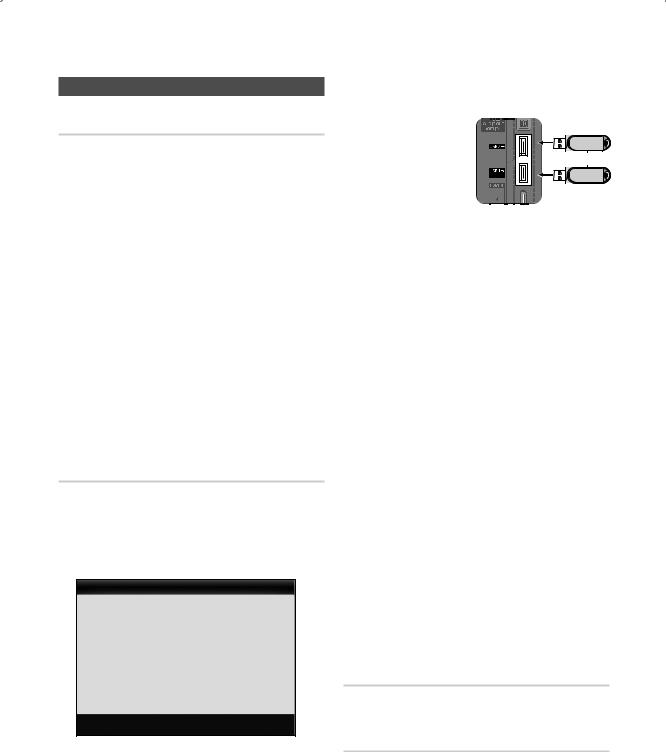
Basic Features
Support Menu
Self Diagnosis
Self Diagnostic might take few seconds, this is part of the normal operation of the TV.
■■ Picture Test (Yes / No): Use to check for picture problems.
■■ Sound Test (Yes / No): Use the built-in melody sound to check for sound problems.
If you hear no sound from the TV’s speakers, before performing the sound test, make sure
Speaker Select is set to TV Speaker in the Sound menu.
The melody will be heard during the test even if
Speaker Select is set to External Speaker or the sound is muted by pressing the MUTE button.
■■ Signal Information: (digital channels only) HDTV channel’s reception quality is either perfect or the channels are unavailable. Adjust your antenna to increase signal strength.
■■ Troubleshooting: If the TV seems to have a problem, refer to this description.
If none of these troubleshooting tips apply, contact the Samsung customer service centre.
Software Upgrade
Software Upgrade can be performed via a broadcasting signal or by network connection or downloading the latest firmware from “www.samsung.com,” to a USB memory device.
Current Version the software already installed in the TV.Software is represented as “Year/Month/Day_Version”.
Software Upgrade
|
Current Version |
2010/01/18_000001 |
|
|
|
|
|
|
|
By USB |
► |
|
By Online |
|
|
By Channel |
|
|
Standby Mode Upgrade |
: 2 Hours Later |
|
Alternative Software |
2010/01/15_00000 |
|
|
UMove E Enter R Return |
Installing the Latest Version
■■ By USB: Insert a USB
drive containing the firmware upgrade file,
downloaded from “www.samsung.com,” into the TV. Please
be careful not to disconnect the power
or remove the USB
drive until upgrades are complete. The TV will be turned off and on automatically after completing the firmware upgrade. When software is upgraded, video and audio settings you have made will return to their default settings. We advise you to to write down your settings so that you can easily reset them after the upgrade.
■■ By Online: Upgrade the software using the Internet.
First, configure your network. For detailed procedures on using the Network Setup, refer to the “Network Connection” instructions.
If the internet connection doesn’t operate properly, the connection may be broken. Please retry downloading. If the problem persists, download by USB and upgrade.
■■ By Channel: Upgrade the software using the broadcasting signal.
If the function is selected during the software transmission period, software will be automatically searched and downloaded.
The time required to download the software is determined by the signal status.
■■ Standby Mode Upgrade: A manual upgrade will be automatically performed at selected time. Since the power of the unit is turned on internally, the screen may be turned on slightly for the LED product. This phenomenon may continue for more than 1 hour until the software upgrade is complete.
■■ Alternative Software (backup): Displays the software version downloaded through By Online. During the software upgrading, When the Upgrade will discontinue from last step, this function be activated.
HD Connection Guide
Refer to this information when connecting external devices to the TV.
Contact Samsung
View this information when your TV does not work properly or when you want to upgrade the software. You can find information regarding our call centres, and how to download products and software.
28 English
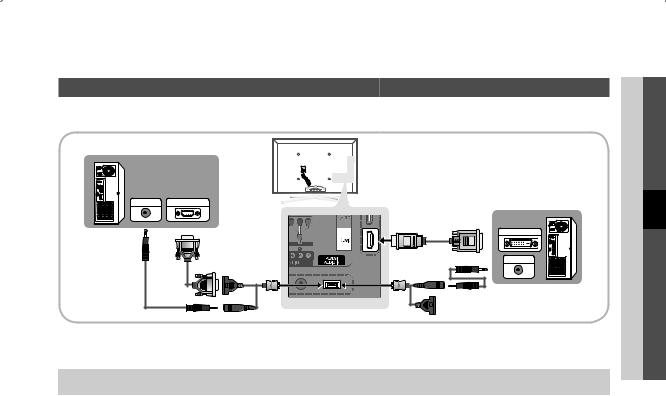
Advanced Features
Connecting to a PC
Using an HDMI/DVI Cable / a D-sub Cable
AUDIO OUT |
PC OUT |
Advanced Features04
DVI OUT
AUDIO OUT
Display Modes (D-Sub and HDMI/DVI Input)
Optimal resolution is 1920 X 1080 @ 60 Hz.
Mode |
Resolution |
Horizontal Frequency |
Vertical Frequency |
Pixel Clock Frequency |
Sync Polarity |
|
(KHz) |
(Hz) |
(MHz) |
(H / V) |
|||
|
|
|||||
IBM |
640 x 350 |
31.469 |
70.086 |
25.175 |
+/- |
|
720 x 400 |
31.469 |
70.087 |
28.322 |
-/+ |
||
|
||||||
|
|
|
|
|
|
|
|
640 x 480 |
35.000 |
66.667 |
30.240 |
-/- |
|
MAC |
832 x 624 |
49.726 |
74.551 |
57.284 |
-/- |
|
|
1152 x 870 |
68.681 |
75.062 |
100.000 |
-/- |
|
|
720 x 576 |
35.910 |
59.950 |
32.750 |
-/+ |
|
VESA CVT |
1152 x 864 |
53.783 |
59.959 |
81.750 |
-/+ |
|
1280 x 720 |
56.456 |
74.777 |
95.750 |
-/+ |
||
|
||||||
|
1280 x 960 |
75.231 |
74.857 |
130.000 |
-/+ |
|
|
640 x 480 |
31.469 |
59.940 |
25.175 |
-/- |
|
|
640 x 480 |
37.861 |
72.809 |
31.500 |
-/- |
|
|
640 x 480 |
37.500 |
75.000 |
31.500 |
-/- |
|
|
800 x 600 |
37.879 |
60.317 |
40.000 |
+/+ |
|
|
800 x 600 |
48.077 |
72.188 |
50.000 |
+/+ |
|
|
800 x 600 |
46.875 |
75.000 |
49.500 |
+/+ |
|
|
1024 x 768 |
48.363 |
60.004 |
65.000 |
-/- |
|
|
1024 x 768 |
56.476 |
70.069 |
75.000 |
-/- |
|
|
1024 x 768 |
60.023 |
75.029 |
78.750 |
+/+ |
|
|
1152 x 864 |
67.500 |
75.000 |
108.000 |
+/+ |
|
VESA DMT |
1280 x 1024 |
63.981 |
60.020 |
108.000 |
+/+ |
|
|
1280 x 1024 |
79.976 |
75.025 |
135.000 |
+/+ |
|
|
1280 x 720 |
45.000 |
60.000 |
74.250 |
+/+ |
|
|
1280 x 800 |
49.702 |
59.810 |
83.500 |
-/+ |
|
|
1280 x 800 |
62.795 |
74.934 |
106.500 |
-/+ |
|
|
1280 x 960 |
60.000 |
60.000 |
108.000 |
+/+ |
|
|
1360 x 768 |
47.712 |
60.015 |
85.500 |
+/+ |
|
|
1440 x 900 |
55.935 |
59.887 |
106.500 |
-/+ |
|
|
1440 x 900 |
70.635 |
74.984 |
136.750 |
-/+ |
|
|
1600 x 1200 |
75.000 |
60.000 |
162.000 |
+/+ |
|
|
1680 x 1050 |
65.290 |
59.954 |
146.250 |
-/+ |
|
VESA GTF |
1280 x 720 |
52.500 |
70.000 |
89.040 |
-/+ |
|
1280 x 1024 |
74.620 |
70.000 |
128.943 |
-/- |
||
|
||||||
|
|
|
|
|
|
|
VESA DMT / DTV CEA |
1920 x 1080p |
67.500 |
60.000 |
148.500 |
+/+ |
|
|
|
|
|
|
|
NOTE
xx For HDMI/DVI cable connection, you must use the HDMI IN 1(DVI) jack. xx The interlace mode is not supported.
xx The set might operate abnormally if a non-standard video format is selected.
xx Separate and Composite modes are supported. SOG(Sync On Green) is not supported.
English 29
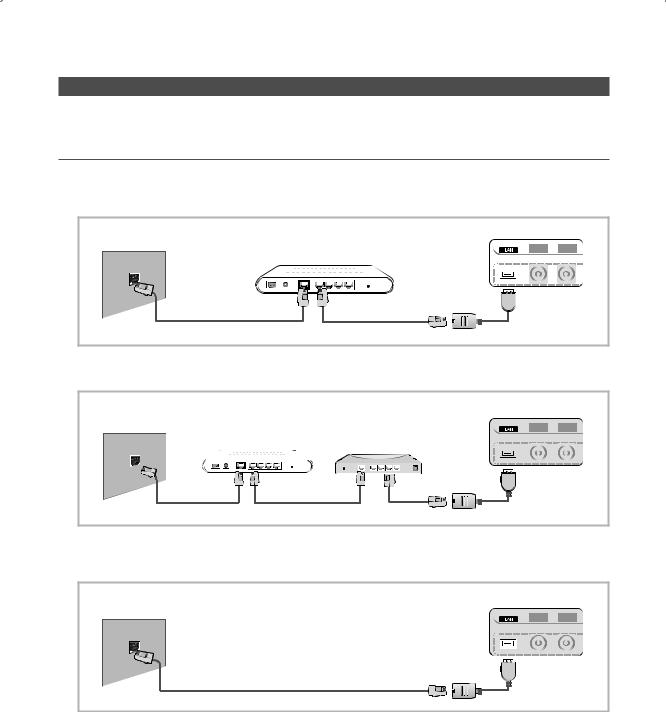
Advanced Features
Network Connection
You can set up your TV so that it can access the Internet through your local area network (LAN) using a wired or wireless connection.
¦¦ Connecting to a Wired Network
You can attach your TV to your LAN using cable in three ways:
yy You can attach your TV to your LAN by connecting the LAN port on the back of your TV to an external modem using a Cat 5 cable. See the diagram below.
TV Rear Panel
The Modem Port on the Wall |
|
|
|
External Modem |
|
|
|
|
|
|
|
|
|
||
|
|
|
|
|
|
|
|
|
|||||||
|
|
(ADSL / VDSL / Cable TV) |
|
|
|
|
|
|
|
|
|
||||
|
|
|
|
|
|
|
|
|
|
|
|
|
|
|
|
|
|
|
|
|
|
|
|
|
|
|
|
|
|
|
|
|
|
|
|
|
|
|
|
|
|
|
|
|
|
|
|
|
|
|
|
|
|
|
|
|
|
|
|
|
|
|
|
 LAN Adapter
LAN Adapter
Modem Cable |
LAN Cable |
yy You can attach your TV to your LAN by connecting the LAN port on the back of your TV to a IP Sharer which is connected to an external modem. Use Cat 5 cable for the connection. See the diagram below.
TV Rear Panel
The Modem Port on the Wall
|
|
|
|
|
External Modem |
|
|
|
|
|
|
|
|
|
|
||||
|
|
|
|
|
IP Sharer |
||||||||||||||
(ADSL / VDSL / Cable TV) |
|||||||||||||||||||
(having DHCP server) |
|||||||||||||||||||
|
|
|
|
|
|
|
|
|
|||||||||||
|
|
|
|
|
|
|
|
|
|
|
|
|
|
|
LAN Adapter |
||||
|
|
|
|
|
|
|
|
|
|
|
|
|
|
|
|||||
Modem Cable |
|
|
|
LAN Cable |
|
|
|
|
|
|
|||||||||
|
|
|
|
|
|
|
|
|
|||||||||||
|
|
|
|
|
|
|
|
|
|||||||||||
|
|
|
LAN Cable |
||||||||||||||||
yy Depending on how your network is configured, you may be able to attach your TV to your LAN by connecting the LAN port on the back of your TV directly to a network wall outlet using a Cat 5 cable. See the diagram below. Note that the wall outlet is attached to a modem or router elsewhere in your house.
TV Rear Panel
The LAN Port on the Wall
LAN Cable
LAN Adapter
If you have a Dynamic Network, you should use an ADSL modem or router that supports Dynamic Host Configuration Protocol (DHCP). Modems and routers that support DHCP automatically provide the IP address, subnet mask, gateway, and DNS values your TV needs to access the Internet so you don’t have to enter them manually. Most home networks are Dynamic Networks.
Some networks require a Static IP address. If your network requires a Static IP address, you must enter the IP address, subnet mask, gateway, and DNS values manually on your TV’s Cable Setup Screen when you set up the network connection. To get the IP address, subnet mask, gateway, and DNS values, contact your Internet Service Provider (ISP). If you have a Windows computer, you can also get these values through your computer.
You can use ADSL modems that support DHCP if your network requires a Static IP address. ADSL modems that support DHCP also let you use Static IP addresses.
30 English
